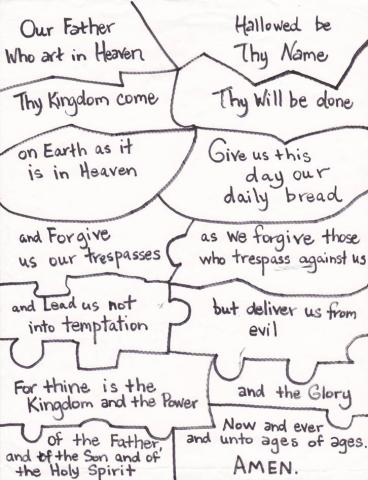Ages 10-12 The Gospels - Overview (Schedule, Recipes, etc..)
CHURCH SCHOOL
THE LIFE OF JESUS – THE GOSPELS
AGES 8-10
This file is provided as a resource for Church School directors. Feel free to plug in your own dates and your own teachers.
TEACHERS:
|
Date |
Lesson/Activity |
Teacher |
Special Notes |
|
September 12
18 19
26
|
Nativity of Theotokos/ Presentation of Theotokos
Movie Night Annunciation
Birth of John the Baptist
|
|
Outdoor, Parish-wide |
|
October 3
10
17
23 24
31
|
Nativity of Our Lord
Meeting of Our Lord
The Three Kings
Movie Night Flight to Egypt
Nazareth and the Temple/ All Saints Party
|
|
Memory Work: St. Simeon’s Prayer
Operation Christmas Child due Dress as favorite gospel character |
|
November 7
14
20 21
28
|
Theophany
Temptations of Jesus
Movie Night Wedding at Cana
Calling of the Fishermen
|
|
Memory : Troparion Jar Decorating
Jewish Dancing
Memory Work: 12 Disciples |
|
December 4 5
12
19
26 |
St. Nicholas Festival Calling of Matthew
Woman at the Well
Christmas Pageant
Sermon on the Mount |
|
10 AM-1 PM in hall
Memory Work: Beatitudes |
|
January 2
9
15 16
23
30
|
Walking on Water/Calming of Storm
Feeding of 5000
Movie Night Transfiguration
The Good Samaritan
Parable of the Sower |
|
Canned Goods 3 Kings Party
Health Kits |
|
February 6
13
17
27 |
Zaccheus
Publican/Pharisee
Prodigal Son
Last Judgment |
|
Homeless Bags
|
|
March 5 6
13
20
27
|
Movie Night Forgiveness/Paralytic
Miracles/Healing
Lazarus
Palm Sunday
|
|
Antiochian Art Contest
|
|
April 2 3
10
17
24 25
30 |
Marathon Movie Night Last Supper
Crucifixion
Resurrection
PASCHA: No Church School Easter Egg Hunt
Rehearsal for Passion Plan/Musical |
|
Memory Work: “Christ is Risen” in 3 languages
|
|
May 1
8
13-15
22
29 |
Passion Play/Musical
Doubting Thomas
Camping Trip Ages 6-12
Myrrh-bearing Women
Road to Emmaeus
|
|
For Parish/Public???
Piggy Banks Due |
|
June 5
12
19 |
Ascension
Pentecost
Lord’s Prayer |
|
Memory Work: Lord’s Prayer Awards Ceremony |
GENERAL NOTES
Classroom supplies: Each class is supplied with the following items:
Paper plates, small and large Scissors Stapler/Staples
Paper, plain and construction Tape and dispenser Paper bags
Glue or glue sticks Crayons and/or markers
Popsicle sticks Chenille (colored pipe cleaners)
If you use the last of something, please either replace it or let me know so I can replace it. If you need special craft supplies for your lesson, submit the receipt to me for reimbursement. Each student will have a Bible and should either leave it in class or bring it each week. There are a couple of copies in the classroom for teachers and guests. Please make use of the great maps and timelines in this Bible.
Teaching Schedule: We all know that there will be last-minute needs; trade with someone if you cannot teach on your assigned day and let the director know!
Insurance: Each of us must “apply” each year for our volunteer position of teacher. Please be sure not to send small children to the bathroom unattended and accompany your charges back to the Social Hall after class.
Opening Exercises: The Church School director will supervise this time, or delegate it when she is absent. Church School children and teachers are dismissed first from Liturgy; children come straight across for snack during opening exercises. These are an integral part of the curriculum – reviewing material from previous weeks, presenting additional Old Testament characters, rehearsing plays, hearing memory work, and playing quiz games.
Curriculum: The Scripture reading for each lesson is listed; if the students are good readers, they can take turns reading; if not, the teacher can read the lesson to them. There are also a craft ideas and discussion questions. Finally, a game suggestion to reinforce the learning in a fun way is included. The lesson plan is one that will work, but feel free to be creative. If you have a good idea for another way to approach the lesson, another craft, etc., go right ahead. Share your idea in writing for inclusion in the next version of the curriculum!
Hand Outs: Feel free to use the coloring pages and puzzles in the Parents' Guide for hand-outs each week. These take homes will reinforce and supplement your lessons.
Movie Nights and Parties: We will have supper after vespers on Saturday night while showing a small children’s movie. Older children should bring a sleeping bag for a lock-in with “feature” presentation on marathon movie night only. We have several of our usual parties planned: All Saint’s, 3 Kings, Easter Egg Hunt, and, this year, the St. Nicholas Festival. All are invited; please bring friends for an outreach opportunity.
RECIPES
CLAYS PAINTS
SALT DOUGH FINGER PAINT (4 WAYS)
2 cups flour Use pudding with food coloring!
1 cup salt Mix liquid starch and food coloring.
about 1 cup water Mix 3 T sugar, ½ cup cornstarch, and
food coloring 2 cups cold water. Cook over
bath oil, vegetable oil, peppermint oil low heat, stirring, till thick.
Mix flour and salt. Add water Pour into muffin tin. Add
slowly and mix with your fingers until food coloring to each cup.
it makes dough. Knead in a few drops
food coloring and a splotch of oil (if SAND PAINT
desired). Store in air-tight container. Add dry tempera paint to corn meal.
Sprinkle over areas “painted” with thinned white glue.
SELF-HARDENING CLAY
1 cup sand for a sand effect. Shake off excess.
½ cup cornstarch
1 tsp powdered alum PASTES
¾ cup hot water PRIMARY PASTE
Food coloring if desired Mix ½ cup water and 1 cup flour
Mix sand, cornstarch and alum in a bowl. Spoon into a jar
in large pot. Add hot water and stir or squeeze bottle to store.
vigorously. Add food coloring if
desired. Cook over medium heat PAPIER MACHE PASTE
until thick, stirring constantly. 3 cups water
After cooling, store in airtight container. 1 ½ cups flour
Mix flour with cold water until lumps are gone.
SAWDUST CLAY
2 cups fine sawdust Dip strips of newsprint in paste and mold around
1 cup flour surface to be shaped. Air dry.
Mix sawdust and flour in bowl
or bucket. Add a little water at a time,
stirring till it is stiff but pliable. Knead
till it’s elastic and easy to shape. Store
in airtight container. Air dry.
CORNSTARCH DOUGH
2 cups cornstarch
4 cups baking soda
2 ½ cups water
Mix cornstarch and soda in large
pot. Add water. Cook, stirring, over medium
heat until thick like mashed potatoes. After
cool, knead on wax paper for 5 minutes. Store
in an airtight container. Air dry.
Nativity of Theotokos and Presentation of Theotokos
NATIVITY OF THE THEOTOKOS AND PRESENTATION OF THE THEOTOKOS
Objectives:
- Students should be able to tell the stories of these two great feasts.
- Students should know the names of Joachim and Anna and Mary.
- Students should be able to list the dates of these 2 immovable feasts.
Possible Lesson Plan:
- Open with prayer.
2. Read the story of the feasts:
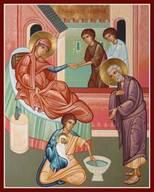 There lived in the land of Israel a couple names Joachim and Anna. Joachim and Anna were Jews; God called the Jews His chosen, or special, people, and had given them His law and His prophets. Through the prophets, God had spoken to His special people, telling them that He would send His Son to be their king. And through the years, God had given the Jewish people many mighty and godly kings, like King David and King Solomon. Joachim and Anna were from the family of David because ancestry was traced from the husband’s line. But, tradition tells us that Anna was descended from Levi, of the priestly line, and descendant of Moses. Together – a couple blessed with the heritage of the greatest of the kings of Israel and the greatest of its prophets – king and priest. Little did they know that their grandson, Jesus, would be the King of Kings, the Messiah promised by the prophets, and the highest of all the High Priests.
There lived in the land of Israel a couple names Joachim and Anna. Joachim and Anna were Jews; God called the Jews His chosen, or special, people, and had given them His law and His prophets. Through the prophets, God had spoken to His special people, telling them that He would send His Son to be their king. And through the years, God had given the Jewish people many mighty and godly kings, like King David and King Solomon. Joachim and Anna were from the family of David because ancestry was traced from the husband’s line. But, tradition tells us that Anna was descended from Levi, of the priestly line, and descendant of Moses. Together – a couple blessed with the heritage of the greatest of the kings of Israel and the greatest of its prophets – king and priest. Little did they know that their grandson, Jesus, would be the King of Kings, the Messiah promised by the prophets, and the highest of all the High Priests.
Joachim and Anna were a righteous couple. But despite years of prayers, they had no children and were getting quite old, too old for children. They went to the temple constantly, praying and offering sacrifices for a child. Now, for the Jewish people, not having any children was considered a disgrace; the couple must be very wicked if God would not bless them even with a child. One day, Joachim brought yet another offering to the temple. The priest was so angry to see him yet again that he threw Joachim out of the temple. Joachim went to the hills outside the city and there prayed and fasted for forty days. An angel appeared to him and told him that they would have a baby, and this baby would be blessed by God. The angel appeared at the same to Anna at home. They ran to meet each other at the gates of the city, full of joy.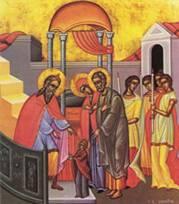
Nine months later, the baby was born. She was given the name Mary. The righteous couple promised the Lord that this child would be dedicated to Him; this promise was later fulfilled with the presentation of Mary at the temple. Several of the early Christian writings of Syria tell us that Mary, theTheotokos was brought to the Temple at age three to be educated, in fulfillment of a vow made by her parents, Joachim and Anna. The feast was instituted in the late 4th century. Mary and her parents approach the Temple in joy, accompanied by Mary’s small friends. Zachariah and the Temple virgins meet her in the Temple courtyard. The Temple is divided into three sections: the outer porch or courtyard, the Holy or nave where only Jews can come to pray and worship, and the Holy of Holies, behind a curtain, where only the high priest can enter, and he only once a year on the Day of Atonement. But, little Mary climbs directly up the steps and into the Holy of Holies, astounding all the people and even the angels.
The church celebrates the birthday of Mary on September 8. We celebrate her entrance into the temple on November 21.
- Review the story again, with the icons. Identify each figure. What was the role of each in the story? Ask the children: How did Joachim and Anna feel when they couldn’t have a child? How do you feel when people say bad things about you? Is it good to say bad things about other people? How did Mary feel when saying good-bye to her parents? Why did she climb the steps to the temple? Would you be brave enough to do that?
- Play a learning game – Don’t Make a Move: Write numbers from 1-10 oneach of 10 popsicle sticks. Ahead of time, write 10 questions about the lesson on cards numbered from 1-10:
Who was Mary’s mother?
Who was Mary’s father?
What word do we use for God-bearer?
What is the date of the feast of the Nativity of the Theotokos?
What is the date of the feast of the Entrance of the Theotokos?
Where was the temple?
How old was Mary when she went to the temple?
What word do we use to mean “birth”?
Where was Mary born?
Who received Mary at the temple?
The first student dumps the 10 sticks in a pile. He tries to remove one without moving the others. If he succeeds, he can try to answer the question corresponding to the number on the stick. If he moves the other sticks, or cannot give the answer, the stick returns to the pile, and the next student tries. The game is finished when all the sticks are removed and all questions answered.
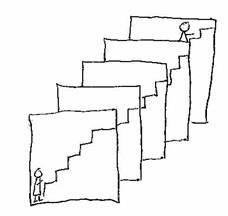
- Make Climbing the Steps. Give each student a pad of paper with 15 sheets; there are pads in the closet marked “paper”. Draw 15 steps on each one, Anna and Joachim at the bottom and Zachariah at the top; simple or stick figures are fine but they should be as close to identical as possible. Now draw Mary at the bottom on the first, 1st step on the 2nd sheet, 2nd step on the 3rd sheet, etc. As you flip the pages quickly, it will look as if Mary is climbing the steps.
- Close with prayer.
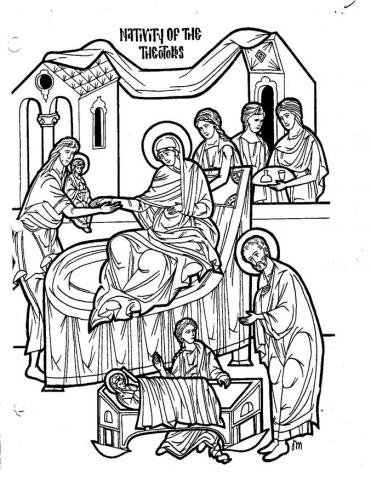
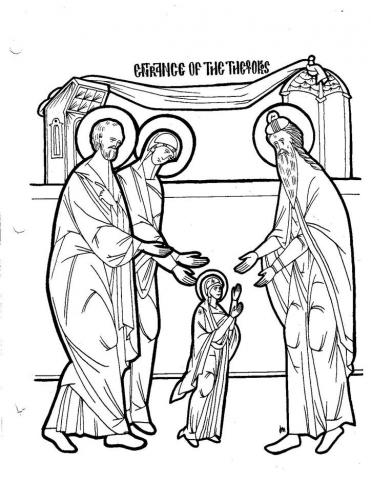
Annunciation
THE ANNUNCIATION
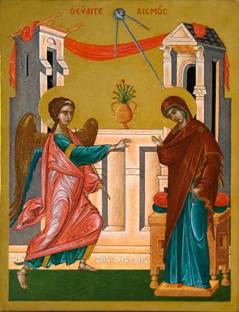 Objectives:
Objectives:
- Students should know that Mary was the mother of Jesus.
- Students should be able to say the word Theotokos and know its meaning.
- Children should be able to say “annunciation” and know it means announcement.
- Students should be able to identify the angel Gabriel and Mary in the icon.
- Students should know that this feast is celebrated March 25.
Possible Lesson Plan:
- Open with prayer.
- Review the icon: See how much the students already know. There are only two participants, Mary and the Archangel Gabriel. Mary carries a spool of yarn, Why? Because just as sheep give their wool to clothe humanity, Mary gave her body to clothe the eternal Son of God in a garment of humanity. What’s on the scroll in the center? Whose prophecy does it depict? (Isaiah)
- Scripture reading: Luke 1: 26-56
- Discussion: What is a mother? Role? Why did Jesus, God Himself, need a
mother? (One cannot be born without one!) Who is the Mother of God? What do we call her? What does “Theotokos” mean?
What word does “annunciation” come from? (“announce”) What is announced? Who does the announcing? From Whom does the message come? Where is the announcement made? Is Mary free to make a choice to accept or not accept what God wishes from her? Would you have accepted and why or why not?
What is the Incarnation? (God taking flesh) In what way was it not only the work of the power of God, but also the work and will and faith of the virgin Mary? . Why is Annunciation exactly 9 months before Christmas? (Discuss the concept of pregnancy and how it occurs with older students; younger students may want to discuss their own mothers’ pregnancies with a younger sibling, etc.)
What is the relationship between Mary and Elizabeth, the mother of John the Baptist? How long had Elizabeth been pregnant when the Annunciation occurred? Compare and contrast the responses of Mary and of Zachariah when each heard from the angel.
- Play a learning game: Write the letters of the alphabet on small pieces of paper, include at least 2 of each letter and 4 of each vowel. Scatter the letters in the center of the floor. Ask questions from the lesson that can be answered with one word:
Who was the angel who came to Mary?
Who is the Theotokos?
In which feast do we celebrate an announcement?
In which month do we celebrate the Annunciation?
When you say the word, “Go”, the students must sift through the letters to form the word that answers the question. The first to lay out the correct letters is the winner.
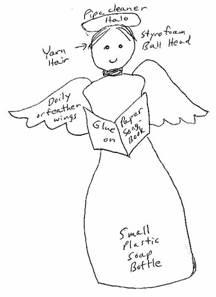
- Make a Bottle Angel: Take a small dish detergent or similar bottle. Add doily, feather, or paper wings, a strip of paper folded for a book, a Styrofoam head with yarn hair and chenille halo.
- Close with prayer.
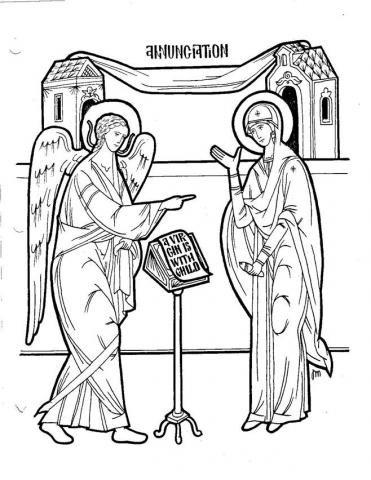
Birth of John the Baptist
BIRTH OF JOHN THE BAPTIST
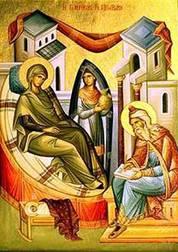
Objectives:
- Students should be able to tell the story of Elizabeth, Zachariah , and the angel.
- Students should be able to identify John as the child of Elizabeth and Zachariah.
Possible Lesson Plan:
- Open with prayer.
- Read the story of John’s birth in Luke 1:1-25, 57-80.
- First review the stories of other “gift babies”: Mary to Joachim and Anna, Isaac to Abraham and Sarah, and Samuel to Hannah and Elkanah. You can even review the stories in Genesis 17:15-21, 21:1-3 and I Samuel 1:1-20. What gift did God give to Elizabeth and Zachariah? How did they feel? What did Zachariah say to the angel? Did he believe God? Do you always believe God? Is it hard sometimes to do what God says? Why couldn’t Zachariah speak? What were his first words? Did he obey God in the end? Who visited Elizabeth before John was born? Remind the students that Mary and Elizabeth were cousins.
- Play a learning game: Make a “Question and Answer Viewer”. Seal a business-size envelope. Cut off both ends, leaving a 6-inch section. Cut two square windows in the front. Label the right window “Question” and the left “Answer” Take a long strip of paper, 3 ½ inches wide and 2 feet long (tape together several shorter lengths). Draw rectangles the same size and distance apart as your windows. In each pair of rectangles, write a question and its answer. Have each student come up with one question for all. Finally, insert the strip into your viewer. As you pull it through, the questions and answers will present themselves!
- Close with prayer. Use the prayer that Elizabeth prayed when she saw Mary coming: “Rejoice, O Birthgiver of God, Mary full of grace, the Lord is with you! Blessed are you among women, and blessed is the Fruit of your womb. For you have borne the Savior of our souls!”
Nativity
NATIVITY OF OUR LORD (CHRISTMAS)
Objectives:
- Students should know that Nativity means “birthday”.
- Students should be able to tell the story of the Nativity and identify the figures in the icon.
- Students should be able to repeat the greeting: “Christ is born! Glorify Him!”
- Students should know the date of this great feast: December 25.
Possible Lesson Plan:
- Open with prayer.
- The icon: Ask how much the students already know about the story of the feast. Who are the characters in the icon? The Theotokos and Child, St. Joseph (being tempted by Satan to doubt the virgin birth), Satan (in dark colors, the Prince of Darkness), a shepherd (facing the angels as they tell of His birth), the Magi (What is their symbolism? 1 beardless and young, one middle-aged, and one old, representing all mankind), the Angels, the cow, and the star. Note: not all icons have the Magi. Is it day or night?
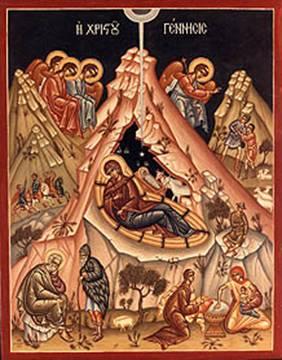
- Scripture Reference: Luke 2:1-20.
- Discussion questions:
What is Advent? How long is it? How do we observe it? Where was Jesus born? Why there? How did God arrange for the prophecy of Micah to be fulfilled? Was he born in splendor like a king or was God’s Son, the greatest king of all, born in a very humble place? Why? (maybe so we can all reach Him personally) What was a stable in Jesus’s day? (a cave)
- Practice the greeting: Christ is born! Glorify Him!” Go around the circle until each child can say each half of the greeting.
- Play a learning game: 20 Questions would be great with the multitude of characters. Write the names of the characters in the icon on slips of paper – Mary, Jesus, Joseph, shepherd, cow, angel, star. Have students select a slip of paper. The other students then ask yes/no questions until they can determine the identity of the character.
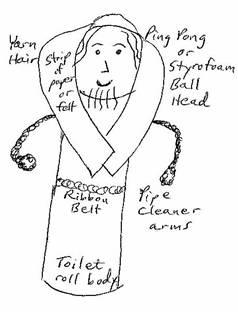
- Make a class creche scene and/or individual Christmas Stained Glass Windows. For the creche scene, assign someone to make Mary, Joseph, Jesus, shepherds, and angels. Use toilet paper tubes for figures, with chenille arms and Styrofoam ball head. Use construction paper for the head covering and any clothing. Re-enact the story using your figures. Leave them in the middle of the table for later lessons.
Then make stained glass windows. Cut pieces from tissue paper (use the pattern or even larger; there are mostly circles and ovals) and lay on a long piece of wax paper, overlapping as needed. Cover with another piece of wax paper and iron lightly.
8. Alternative Craft: Make the 3-D pop-up card for Nativity. Pattern to follow. Print all on heavy cardstock and cut out. Fold down top edge of base of card and fold middle of card so the back stands up. Cut out the hole for the cave in the mountains. Cut the slits on the top and bottom of the base of the card. Slide each figure into its slot, pushing in all the way, and tape in place underneath. You can put Joseph in the slot marked Jesse tree and cut a matching slot on the other side for the tree.
9. Close with prayer.
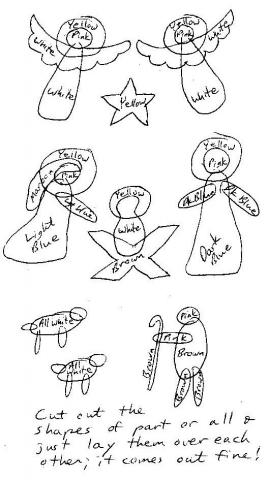
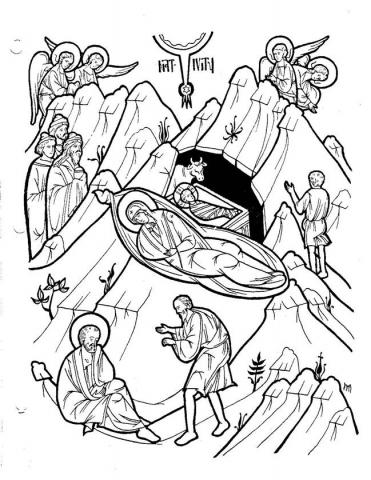
The Meeting of the Lord
THE MEETING OF THE LORD
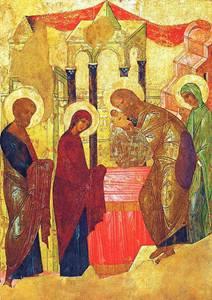 Objectives:
Objectives:
- Students should be able to tell the story of the meeting of the Lord.
- Students should be able to identify Simeon and Anna, as well as Jesus, Mary and Joseph in the icon.
- Students should know what churching is and that this feast is its origin.
- St. Simeon’s prayer is our memory work this week.
- Students should know the date of this feast, February 2.
Possible Lesson Plan:
- Open with St. Simeon’s Prayer: “Lord, now lettest Thou Thy servant depart in peace according to Thy word, for mine eyes have seen Thy salvation, which Thou hast prepared before the face of all peoples, a light to enlighten the Gentiles, and the glory of Thy people, Israel.
- Present the icon; see how much the students already know: St. Joseph on the extreme left (why is he so old?), Mary the Theotokos next to Joseph, the baby Jesus, St. Simeon the God-receiver, St. Anna the Prophetess, the entrance to the Holy of Holies, the most sacred section of the Temple.
- Scripture reading: Luke 2: 22-40: How many days after Jesus was born was He brought to the Temple? When is this feast celebrated? (February 2) What had God promised Simeon and Anna? Did He keep His promise?
- Bring an infant baby doll, wrapped in a blanket. Tell the children that each baby is brought to the church when he or she is a few weeks old. Just as in the days of Jesus, the mothers and fathers thank God for their new child and ask Him to take care of their baby and help him to grow up as a good member of God’s family. This is called churching. Act out a churching, with the teacher as priest, and a little girl holding the baby, a little boy as father.
Priest: Let us pray to the Lord. O Lord God Almighty, Father of our Lord Jesus Christ, purify this woman, (name), from all sin and bless thou the child, (name), who is born of her. (Make the sign of the cross over the child.) As Thou, O Lord, wast brought on the fortieth day as an infant in to the Temple according to the Law by your mother, Mary, and wast carried in the arms of Simeon the Just, do Thou, O Master, bless this baby who is brought here. For unto thee are due all glory, thanksgiving and worship. Amen.
- We bless candles on this feast day. Simeon and Anna were two old people who had been waiting a long time for Jesus, who would be the light of the world. We celebrate the light of Jesus with the blessing of candles. We use candles made of beeswax because God gives us His bees to make the wax. You can make new beeswax candles by re-using the stubs of beeswax left in your parish. Melt them down -- one easy way is to use a disposable foil pan on a simple hotplate (no flames, please). Pour into molds -- no mold? You can re-use the waxed paper cartons used in schools for milk or even a waxed paper cup! Fill the mold or cup with ice for a candle that is "holey" or put in some rocks or seashells for variety. No way to melt wax? Take one of the tall votive candles, the weeklong type, color the icon of the feast, cut to fit, and use Mod-Podge to glue it on, covering it with a thick layer of Mod-Podge. Take it home and burn it all week in your icon corner, or burn it in your sanctuary.
- Play a learning game: Bible Match. Write each question on a slip of paper and its answer on another. Hand out the slips of paper. Each student must find his partner – the student with the answer to his question. They then sit down together.
Who was the elder God promised he would see the Messiah? // Simeon
Who was the elderly woman who waited in the temple? // Anna
Who was the mother of Jesus? // Mary the Theotokos
Who was Mary’s husband? // Joseph
Who was the Messiah? // Jesus
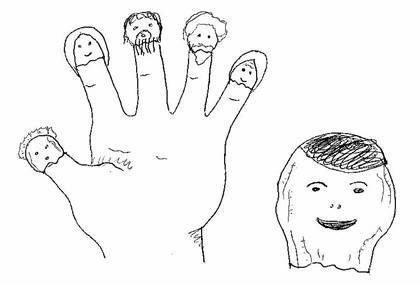 Make Peanut People Finger Puppets: Break peanuts in half for each puppet. Draw on faces and add cloth or paper headcoverings, yarn hair and beards, etc. Practice telling the story with the finger puppets. Someone in the class allergic to peanuts? No problem. Take small strips of construction or cardstock paper. Tape into cylinders and decorate in the same way as finger puppets.
Make Peanut People Finger Puppets: Break peanuts in half for each puppet. Draw on faces and add cloth or paper headcoverings, yarn hair and beards, etc. Practice telling the story with the finger puppets. Someone in the class allergic to peanuts? No problem. Take small strips of construction or cardstock paper. Tape into cylinders and decorate in the same way as finger puppets.
- Close with St. Simeon’s Prayer. Recite the prayer line by line with the children repeating. Or try singing it a couple of times like we do at vespers. Do it all together at the end with lighted candles.
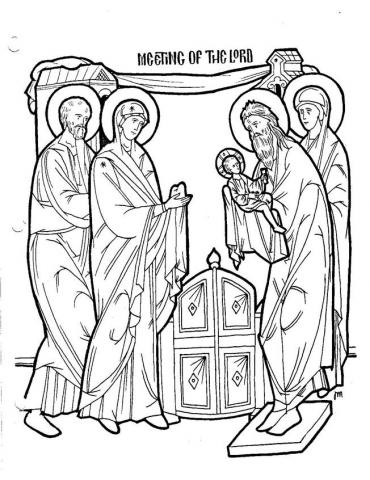
The Three Kings
THE THREE KINGS
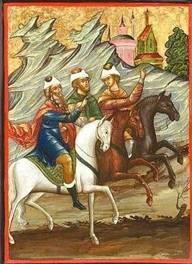 Objectives:
Objectives:
- Students should be able to tell the story of the three kings, or wise men.
- Students should know that the star guided the wise men to Bethlehem.
- Students should be able to name Herod as the wicked king who wanted to kill Jesus.
- Students should be able to name the gifts the kings gave the baby Jesus.
Possible Lesson Plan:
- Open with prayer. Review St. Simeon’s prayer. Have the children memorized it yet?
- Scripture reading: Matthew 2:1-12. Review the icon of the Nativity. Where are the three kings? Add them to your crèche and review all the other figures in the icon and the crèche scene. Does the Bible actually tell us how many kings there were?
- Discussion questions: What were the gifts of the kings? What might be the meaning of these gifts? (gold for a king, incense for a priest, myrrh for His burial) Why did Herod hate Jesus? What did God tell the wise men to do? Who were the Magi? (highly respected scholars and scientists of Persia, astrologers and the most educated men of their day) Symbolism of these men of high rank coming and bowing before a poor, naked child? (possibly prefiguring the redemption of all the nations, not just the Jews), Symbolism of those traveling from the Orient to the true Orient from on high, following the light of a star to the one true light?
- Play a learning game: The Big Step. Line up all the students against a wall. The opposite wall is the finish line. Each player must in turn answer a question about today’s lesson. If successful, he advances one step, as large as he can make it, towards the finish line. Some sample questions:
Who was the king at the time of Jesus’s birth?
What did the magi follow to find the baby?
Where was the baby Jesus?
What were the 3 gifts brought by the magi?
To what city did the magi go first?
How many magi were there according to the Bible?
The magi came from what direction?
Where did the magi go after leaving Bethlehem?
- Make king crèche figures and add to the class crèche scene (see Nativity lesson). Then each student can make paper stars; they’ll make great decorations for the Christmas tree.

- Alternate craft idea: Three Kings mobile. Color the kings. Cut apart on the lines between the sections. Fold each section into a triangle and tape together. Then hang the triangles with a string down the center, allowing each to turn and put different heads with different gifts and different feet.
- Close with prayer.
Flight to Egypt
FLIGHT TO EGYPT
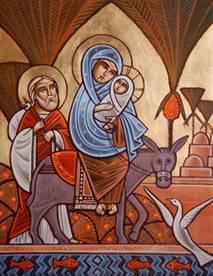
Objectives:
- Students should know how the angel Gabriel helped Joseph care for Jesus.
- Students should learn that the Holy Family was accompanied to Egypt by James, oldest son of Joseph by his first marriage.
- Students should be able to discuss Egypt and Moses.
- Students should recognize Herod as the wicked king who killed the children.
Possible Lesson Plan:
- Open with Prayer.
- Scripture Reading: Matthew 2:13-23. Who warned Joseph? Who wanted to kill Jesus? Why? Where were Joseph and Mary and Jesus living and where did they go? Tradition teaches us that Joseph had been married before to Solomonia; he was widowed and had 4 sons and 2 daughters when he married the Theotokos. The eldest of these sons, James, accompanied the Holy Family to Egypt. Why Egypt?
- Discussion questions: Historically what is the importance of Egypt? Review the stories of Joseph and Moses. Symbolism of Jesus also coming out of Egypt? Initiate a map search. Where are the countries: Phoenicia, Egypt, Galilee, Samaria, and Judea? Add in the rivers (Nile and Jordan), lakes (Dead Sea and Sea of Galilee) and the Mediterranean Sea. Where’s Sinai? Now for cities: Find Jerusalem, Jericho, and Bethlehem in Judea; Nazareth and Capernaum in Galilee, Caesarea on the Mediterranean. Retrace the path of Jesus from Annunciation in Nazareth to Bethlehem to Jerusalem (for the Meeting in the Temple), back to Bethlehem, then to Egypt, and finally to Nazareth. For future reference, locate Samaria, Capernaum, and Jericho. Use the maps in your box as illustrations, but have the students mark their own for learning.
Talk a bit about the role of prophecy. Many prophecies were fulfilled in the life of Jesus; God had prepared His people well to recognize the Messiah through the many prophecies in the Old Testament. Can the students name some that have already been fulfilled? (born of a Virgin, born in Bethlehem, of the house of David, seen by Simeon, John’s birth as the forerunner) Read Jeremiah 31:15. How was this prophecy fulfilled? (the murder of the children of Bethlehem)
- Historical background: Who ruled in Israel? Review the rulers of Israel from the Old Testament – the judges (e.g. Gideon, Samuel), the first king Saul, David, Solomon, and finally the rule of the Babylonians and Persians. Do the students remember the rule of the Greeks, under Antiochus, in the story of Hanukkah. At the time of Jesus, Rome had ruled Israel for 100 years. But, they ruled it with a king – King Herod (the Great???). Herod tried to win the love of the people by rebuilding the temple, but he was hated and feared for his throne. When he died, during Jesus’s childhood, his kingdom was divided among his three sons. This went so badly, that the Romans finally stepped in and, by the time of Jesus’s crucifixion, the land was ruled by a Roman governor, or procurator, named Pontius Pilate. The kings remained as figureheads but were powerless.
- Play a learning game: Timeline Cards. Print the cards ahead of time and cut apart. Can students put them back in the correct order? Have each student glue the squares onto a long strip of paper like a long comic strip leaving one space before and after their timeline figures. Fold between scenes like a fan and glue manger left and right to first and last scenes to make a 3-D card. Color the scenes if desired.
6. Make a 2-sided Stick Puzzle: Take 12 large popsicle sticks and line them up carefully, using tape on one side to hold them together. Glue icon of the Flight to Egypt to one side with Mod Podge. These are Coptic icons, right from Egypt! Flip the icon over with the now-attached sticks, remove the tape, and glue the icon of the angel Gabriel warning Joseph to take Mary and the baby Jesus to safety to the other side. Cut sticks apart. Trim as needed. Put all sticks in an envelope.
7. Close with prayer.
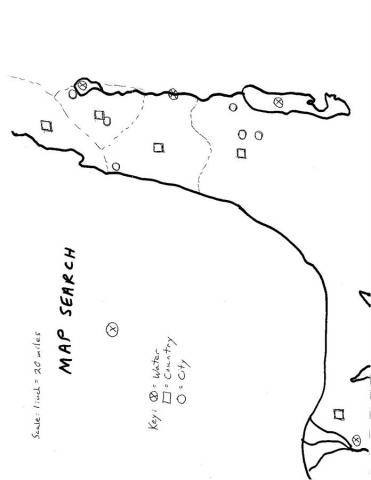
Nazareth and Trip to Jerusalem
NAZARETH AND THE TRIP TO JERUSALEM
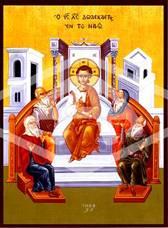 Objectives:
Objectives:
- Students should identify Nazareth as the childhood home of Jesus.
- Students should know that Joseph was a carpenter, and so was Jesus.
- Students should be able to relate the story of the trip to Jerusalem and Jesus talking with the elders in the Temple.
Possible Lesson Plan:
- Open with prayer.
- Scripture reading: Luke 2:40-52. Why did the family come back from Egypt? Why did they settle in Nazareth instead of returning to Bethlehem?
- Historical background: It is important to recognize and understand the roles of the various religious places and groups if one is to understand both the trip to Jerusalem and Jesus’s later ministry. See if the students already know any of these important people and places and help them to understand them better:
Temple: There was only one temple, in Jerusalem. There was the Ark of the Covenant and sacrifices were offered. People who lived far away would try to make a pilgrimage to the Temple at least once in their lives.
Synagogue: Each town had its synagogue, where on Sabbath the people came to listen to the Scriptures being read. The synagogue was also the local school. But no sacrifices could be offered here; there were no priests.
Priest: Priests, descendants of Aaron (Remember the story of the rod that budded?), offered sacrifices in the Temple. The High Priest entered the Holy of Holies once a year to sacrifice for all the people.
Levites: One of the twelve tribes of Israel (Remember the brothers of Joseph; one was Levi). Instead of receiving land, the Levites served in the Temple with the priests.
Sanhedrin: The Jewish Supreme Court, composed of the high priest, all previous high priests, all the heads of the tribes and heads of the political parties – 71 in all.
Rabbi: A local teacher who served to read and explain the Scriptures.
Scribe: Those who copied the Scriptures as the scrolls wore out and set down rules for every occasion from the books of the law.
Pharisee: Synagogue leaders who carefully studied and obeyed the Law.
Sadducees: Rich landowners who supported the Roman rulers and were not interested in changing the government.
Zealots: Rebels who hated the Romans and thought the Messiah would come as a fierce warrior king to oust the Romans and return Israel to the Jews.
Gentiles: All the people in the world who are not Jewish.
- Play a learning game: Pictionary. Write the words defined above on pieces of paper. Have the first player choose a word and draw it, with the rest of the class guessing the identity. Play then passes to the next student until all words are identified.
- Make a scroll, like the one Jesus might have used as a boy. Use a pencil or a small dowel for each end and glue or tape on the piece of paper. Have each student make several – then have each student suggest a question to be written on each set of scrolls. Put all the scrolls for the student in a tin can, covered with paper. Write “Unroll a Scroll” on the paper. Have the students take the scrolls home. Can they answer all the questions? Can their brothers and sisters?
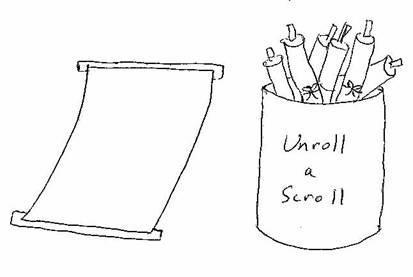
6. Another craft option: Make a mezuzah -- “Hear, O Israel, the Lord our God, the Lord is One” The mezuzah has this very Scripture inside, and is mounted on the doorpost of each Jewish home, to be touched and recited each time one enters or leaves. The mezuzah would surely have been on the home of Jesus in Nazareth. You can mount it by the door of your home also. First write the scripture on a tiny piece of paper and roll into a scroll, or print the one provided.
You will need:
- Matchbox (empty, obviously)
- Masking tape
- Craft (aka popsicle) stick (plain or color)
- Tissue paper (more than one color) cut into 10-15 one-inch squares
- White glue or Mod Podge
- Small paintbrush
Instructions:
1. Tape the stick to the back of the matchbox lengthwise. Don't tape the box shut. Put the scroll inside.
2. Brush thin layer of glue on matchbox—including over the tape.
3. Press individual layers of the tissue squares on box (except the open ends). Keep brushing glue and pressing layers until it looks gorgeous.
Another craft options if the first seems too much like school and the 2nd too messy? Print the background and figures of people of Nazareth doing traditional activities on cardstock and cut out the people, folding back the bottom colored rectangle. Fold the scenery up at the marked line and cut slits where the colored lines are. Using the color coding, stick the bottom of the house and each figures thru the slit and tape underneath. It will stand up like a diorama. Don’t worry about the two figures on the scenery section; they will look fine and stand out from the background when slid into their slits. Every Jewish boy had to be trained in an occupation of some sort. See if you can find the carpenter (Who was a carpenter?), fishermen, rabbi, soldier, baker, tentmaker, farmer, shepherd, potter, and blacksmith.
Even easier: Print the long double scenery on cardstock and tape together to make a very long scenery section. Color, and fold in 4-5 places so it will stand up. Now just glue on your people in place or stand the scenery up, and stand each of the people up on their little bases in front of the background.
7. Close with prayer.
Theophany
THEOPHANY
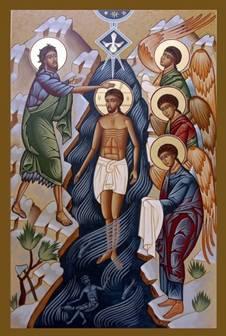
Objectives:
- Students should be able to discuss the icon, knowing each character and its role.
- Students should know that Jesus was baptized in the Jordan River and be able to locate it on a map.
- Students should know the date of the feast, January 6.
- Students should be able to sing the Troparion, since they will need that for their house blessing.
Possible Lesson Plan:
- Open with prayer.
- The icon (Use this to see how much the class already knows and to retell the story.): Christ, the central figure, St. John the Baptist (why is he dressed in brown animal skin?), the angels, the Holy Spirit in the form of a dove, the river Jordan
- Scripture readings:
Gospel: Matthew 3:13-end of chapter, Luke 3:1-18, John 1:19-37
- Songs of the Feast: Troparion: When thou, O Lord, wast baptized in the Jordan, the worship of the Trinity was made manifest. For the voice of the Father bore witness to Thee, and called Thee His beloved Son, and the Spirit in the form of a dove confirmed the truthfulness of His words; O Christ Our God who hast revealed Thyself and hast enlightened the world, Glory to Thee!
Practice singing the Troparion; this is the week’s memory work.
- Discussion questions:
Who was the last and greatest prophet of Israel? (John) How were the Jewish people prepared to be “shown” the Messiah? Did John recognize Jesus when He arrived? In what ways is John the new Elijah? (Elijah’s mantle of prophecy was passed on to Elisha and from him in an uninterrupted chain of prophets, of whom John is the last)
How old was Jesus when He was baptized? How had He lived up until this time? (as an ordinary working man, a carpenter, in Nazareth) Did Jesus need to be baptized because He was a sinner? Then why was He baptized? (He was fulfilling His responsibility to represent all of creation in being cleansed.)
What does Theophany mean? (Theos meaning “God” and Phanos meaning “to show”) We meet here the Trinity for the first time in the New Testament. How was the Trinity present at Theophany? We reaffirm the 3 natures of the one God every time we make the sign of the cross. How? Why do we bless the water at Theophany? What do we use it for through the year? (house blessing, illness, etc.)
- Review the custom of House Blessing. When do we bless houses? Who blesses them? What do we use? Where do we get the Holy Water? What do we sing?
- Ask the students if they have ever seen a baptism? What’s it like? Why are we baptized? (to become part of God’s family, the Church) Sing together “As many as have been baptized…” How was Jesus’s baptism like our baptisms? Different?
- Play a learning game: Play “Final Jeopardy”. Write each important word from today’s lesson (e.g. Theophany, John the Baptist, dove, January 6, Jesus, Noah, Elijah) on a card. Each student should have 7 cards. When the teacher shows the answer card, each student should write a question for which that would be the answer. The students turn their question cards over until all are ready. Show the questions and each correct answer gets 10 points; wrong answer loses 5. Continue through all 7 answers and questions.
- Make a Come Alive Mural: Draw the icon HUGE on a huge piece of bulletin board paper (or brown wrapping paper). Let the children color the figures, each one concentrating on a particular figure. Cut out the faces and hold the paper up near a wall. You may have to do this in the Social Hall with parents to help hold. Let the children take turns with their faces behind the figures. When everyone’s had a chance, cut up the mural and let each take home his portion.
- Close with the Troparion and prayer.
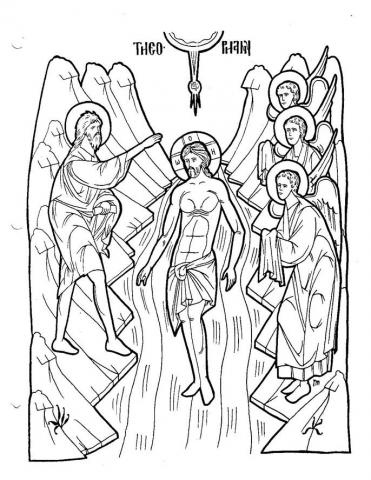
Temptations
TEMPTATIONS
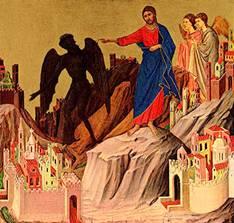 Objectives:
Objectives:
- Students should identify the devil, Satan, as the one who tempted Jesus.
- Students should know that Jesus did not sin.
Possible Lesson Plan:
- Open with prayer.
- Scripture references: Luke 4:1-13 and Matthew 4:1-12. Where did Jesus go after his baptism and why? St. John Chrysostom explained it in this way: “Think of a wrestler. In order for him to teach his students how to wrestle and win, the wrestler himself gets into a contest with others. He shows his students what to do, so that they can learn to defeat their opponents.”
- Discussion: Who is the devil? (Satan, a fallen angel) Review the stories of Adam and Eve and their temptation and of Job. What is the devil’s role in each? What do the godparents do to the devil at a baptism and why?
He tempted Jesus in three ways. What was the first? (food) Jesus had been 40 days without food. Was Jesus man or God? Was He hungry? How did Jesus answer the devil? Will God provide our needs?
What was the 2nd temptation? (jump off the temple and show off His power) What did the devil quote to Jesus? (Scripture) the whole verse? (NO, only part of the truth) Here we see that the devil is a liar and sneaky. What did Jesus answer?
What was the 3rd temptation? (all the kingdoms of the world – power and wealth) What does this tell us about Satan? (He has the power to give away riches, but at a price) Is the devil weak or strong? Who is stronger, God or the devil? How did Jesus answer?
- Ask some questions: What are some temptations faced today? Make headings on chalkboard: School, Home, Play, any others the students can come up with. Brainstorm for situations where the student would be tempted to disobey God. A lost $20 bill found in the playground? Cheating on a test? Lying to get out of trouble? Pocketing a small bottle of nail polish at the dimestore? What would Jesus want us to do in these situations? The devil? Is it a sin to be tempted? Or to choose to do wrong?
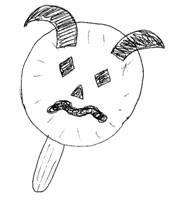 Make a devil mask: Take a red or black plate. Draw mean-looking features and cut out eyes. Add horns. Tape on Popsicle stick to hold it with. Use your mask to play the next game; the Tempter will use the mask.
Make a devil mask: Take a red or black plate. Draw mean-looking features and cut out eyes. Add horns. Tape on Popsicle stick to hold it with. Use your mask to play the next game; the Tempter will use the mask.
- Play a learning game: Tempters and Resisters. Divide the class into Tempters and Resisters in pairs. Each tempter must pose a temptation in his own words and the resister must counter it (specifically, not just as “no”). Act out each situation for the class. Then change roles and do it again!
- Close with prayer.
Wedding at Cana
WEDDING AT CANA
Objectives:
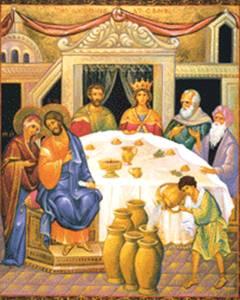 Students should identify the water into wine as Jesus’s first miracle.
Students should identify the water into wine as Jesus’s first miracle.- Students should know the word “miracle” and what it means.
- Students should recognize that the wedding at Cana is part of our wedding service.
Possible Lesson Plans:
- Open with prayer.
- Scripture Reference: John 2:1-11. Why was Jesus in Cana? Who asked him to supply more wine? How was the wine supplied? Remind the students that this was Jesus’s first miracle.
- Discussion: What is a miracle? How do we recognize that a miracle has occurred? Does nature follow a common pattern? Apples fall down, grapes turn to wine, etc. If an apple flew up or water turned to wine, people would notice. Why? What were some types of miracles Jesus did? Brainstorm a bit – healing, raising people from the dead, casting out demons, changing nature. Watch for these in later lessons.
- Talk a bit about weddings. What are the parts of an Orthodox wedding service? (Betrothal, Crowning, Prokeimenon, Gospel, Procession, Cup of wine, Removal of crowns) What happens after the ceremony? (reception/party) What’s a party like? What do you like to have at a party? What might adults like to have? What would it be like to run out of drinks with all those guests?
- Usually, there’s singing and dancing at a Jewish wedding. Enjoy some of the dances you learned last week at movie night.
- Play a learning game: “Quotations”. Read quotations from the Scripture passage and have the students identify the speaker. For example:
“Fill the waterpots with water.” Jesus
“They have no wine.” Mary
“You have kept the good wine until now.” Steward
“Whatever He says to you, do it.” Mary
“My hour has not yet come.” Jesus
“Draw some now and take it to the headwaiter.” Jesus
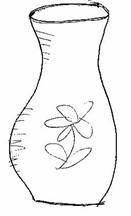
- Make The Steward’s Clay Pots: Take any sort of clay; they sell some nice Mexican reddish air-dry clay at most craft stores. Children love to make things of clay. Try making a pot shaped like a vase. It’s ok to paint on air-dry clay with acrylic paint even before drying if you want to decorate your pots. If you’re able to get a waterproof clay, the pots can be used as vases; otherwise, warn the children to use only silk flowers.
- Close with prayer.
Calling of the Fishermen
CALLING OF THE FISHERMEN
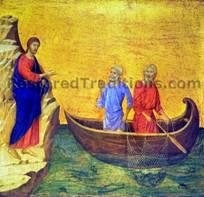 Objectives:
Objectives:
- Students should be able to name all 12 disciples.
- Students should be able to tell the story of the miracle of the full nets.
- Students should be able to say the word “disciple” and know that Jesus’s disciples were His closest followers.
Possible Lesson Plan:
- Open with prayer. As you finish praying, why not make some fish in nets for the children to eat while reading and discussing? Take some small curly pretzels. Provide icing colored blue and goldfish snacks. Children can dab some blue icing onto pretzel "net" and stick on the goldfish for a "catch".
- Scripture references: Matthew 4:18-22, Mark 1:16-20, and Luke 5:1-11. When did Jesus first meet Andrew? (He was a follower of John the Baptist.) Why is Andrew called the “First-called”? Who was Andrew’s brother? (Simon, later named Peter by Jesus) Who were the sons of Zebedee, also brothers? (James and John) What do you think Peter said when he saw all those fish in his net?
- Talk a bit about being a disciple. What is a disciple? (a person who follows the teachings of a teacher) Jesus had 12 close disciples, but many followers. What did the fishermen have to do to become Jesus’s disciples? Did they enjoy fishing? How do you think they felt leaving their homes and families? Was it easy being a disciple? We are also Jesus’s disciples. What does Jesus ask us to do? Is it always easy?
Sometimes we are confused by the reference to disciples and apostles. Many of these men were the same. Disciples are students and followers. Apostles are people sent forth to do something – in this case to teach the world about Jesus. Which disciple never became an apostle? (Judas Iscariot)
- Begin to list and memorize the 12 disciples: Peter and Andrew, James and John, Matthew, Philip and Nathaniel Bartholomew, Simon the Zealot, James (the Less), (Doubting) Thomas, Judas (or Thaddeus), and Judas Iscariot. Here’s a song that may help, to the tune of “Old McDonald”:
Peter, Andrew, James, and John, fishermen were they.
Simon Zealot, James the Less, Judas Thaddeus.
With Philip and Nathaniel Bartholomew,
Doubting Thomas and Taxman Matthew,
Judas Iscariot last of all; he the Lord betrayed.
- Play a learning game: Concentration. Write the name of each of the 12 disciples twice in random order in rows on the large tablet. Cover each name with a Post-It Note with a number from 1-24. Players take turns guessing two numbers; if the names match, the player continues. If not, the Post-It notes are replaced and the next student tries.
- Make Fishers of Men. Cut out about 20 fish for each child. Write the name of a disciple on 12 of them and other names on the rest. Clip a paperclip to each fish. Make a fishing pole with pencil, string, thumbtack, and a piece of magnet for a hook; almost any magnet will do, even the self-adhesive strips. To play the game, put the fish in a bowl. Catch a fish with the magnet and pull it up. The child should decide whether the name is a disciple or not. Keep the disciples and throw the rest in a pile as discards. Continue until all fish are caught.
Too involved? Make the fishing boat of the disciples with just paper pattern and paper towel tube. Print the boat on cardstock and cut out and fold as indicated. Print sail on regular paper and cut out. Color boat. Staple the boat together ONLY in bow and stern. Put paper towel tube in the middle as mast; it will now stand up. Add string tied at bow and stern and thru slits in top of tube. Then glue or tape on the sail on the front of the tube.
- Close with prayer.
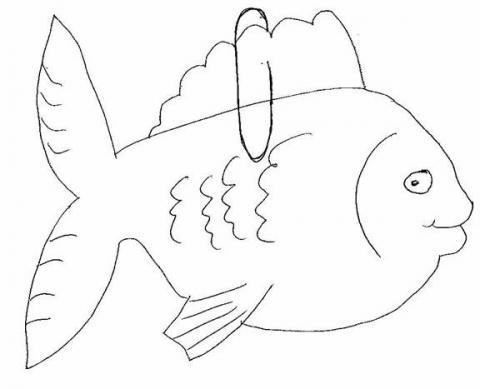
Calling of Matthew
CALLING OF MATTHEW
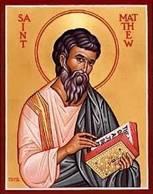
Objectives:
- Students should know that Matthew was a tax collector.
- Students should know that Matthew was one of Jesus’s disciples.
- Students should memorize the 12 disciples.
Possible Lesson Plan:
- Open with prayer.
- Scripture References: Matthew 9:9-13 and Luke 5:27-39. What was Matthew’s job? Was he liked by most people? Why or why not?
- Historical reference: Publicans, or tax collectors, were Jews who contracted with the Roman government to collect taxes for them. They routinely charged more to the Jews than the Romans demanded, keeping the profit for themselves.
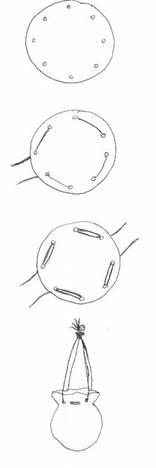 Talk a bit about liking people: Make 2 columns on your chalkboard or large tablet, one labeled “good” and one “bad”. What makes someone a good friend, a nice person? Have the students come up with some characteristics. What makes someone a “bad” person? Did most people think Matthew was a nice person or a bad person? Why? Did most people like Matthew? Did they visit him? Were they nice to him? How did Jesus treat Matthew? Read the “Golden Rule” in Luke 6:31-33. Do you know some people who are not so nice? How do we treat people who are not so nice? Are we being like Jesus?
Talk a bit about liking people: Make 2 columns on your chalkboard or large tablet, one labeled “good” and one “bad”. What makes someone a good friend, a nice person? Have the students come up with some characteristics. What makes someone a “bad” person? Did most people think Matthew was a nice person or a bad person? Why? Did most people like Matthew? Did they visit him? Were they nice to him? How did Jesus treat Matthew? Read the “Golden Rule” in Luke 6:31-33. Do you know some people who are not so nice? How do we treat people who are not so nice? Are we being like Jesus?
- Play a learning game: “Name the Twelve”. We’re still working on the names of the twelve disciples. Print the names on strips of paper and pin a paper to the back of each student. The students must find out which disciple they are by asking the other students yes or no questions. Have the student sit down when he or she thinks he knows who he is. If anyone can’t seem to guess, give clues, e.g., begins with B, etc.
- Make a Money Pouch: Take a circle of leather or heavy fabric or felt. Cut 8 holes around the top. Use 2 shoelaces or heavy yarn or twine for each pouch and lace around the top, one in each direction. Pull tight and knot drawstring. Decorate the outside with fabric markers or acrylic paint if desired.
- . Now make a coin for the pouch. When Jesus was asked if we should pay taxes to the government, He replied, “Render to Caesar the things that are Caesar’s, and unto God the things that are God’s” (Luke 20:25). Take a piece of self-hardening clay and flatten into a disk. On one side, the children can draw with a pencil or skewer the image of Caesar, and on the other a picture of your church, or the Jewish temple. Allow to dry for the week and send home in the pouches next week.
- Close with prayer: Have students pray specifically for someone who does not seem to be very nice and continue praying through the week.
Woman at the Well
THE WOMAN AT THE WELL
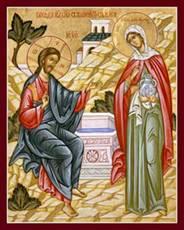 Objectives:
Objectives:
- Students should be able to tell the story of Jesus and the woman at the well.
- Students should be able to say the word, “evangelism” and know that it means telling people about Jesus.
Possible Lesson Plan:
- Open with prayer.
- Scripture reference: John 4:1-43.
- Historical setting: The Samaritans were descendants of the Jewish people who remained in Israel after the rest of the people were carried off into captivity. They intermarried with the people of the land, but continued to worship one God, although not at the Temple in Jerusalem. The Jewish people looked down on them in general as of impure blood.
- Discussion questions: Who made the well Jesus rested on? Review the story of Jacob and his return from exile in Genesis 33: 18-20. Why was the woman surprised that Jesus would speak to her? What kind of water did Jesus offer the woman? Who did the woman say would tell all things to the people? What was Jesus’s response? What did the woman do? What 2 things caused the people of Samaria to believe that Jesus was the coming Messiah? The woman at the well was named Photini and became one of the earliest Christians.
- Talk a bit about evangelism: What does it mean? Was that what the woman at the well did? Was she excited to tell her friends what Jesus had said? Is there anyone you know who does not know about Jesus? Have you told them? Why or why not?
- Learning Game: Truth or Consequences. Each student takes a turn standing as player. The teacher should ask a question based on today’s lesson. If the student knows the answer, he can sit down. If he does not know the answer, the rest of the class decides on a “consequence”, subject, of course, to veto by the teacher if there is danger or mess involved. Suggest simple but funny punishments like doing a backwards somersault or standing on the head or rubbing the stomach while patting the head.
- Make the Woman at the Well Game: Cut several paper jars for each student. Write on each a question about the woman at the well. Each student in the class can make up one question for all to share. Make a well from a 28-32 oz. tin can; the outside can be covered with gray construction paper and lines drawn like stone. Tie a string to a small hole in each jar and put the jars in the well with the strings hanging over the side. See if the student can answer the questions drawn from the well. Can his brothers and sisters?
- Close with prayer. Lord Jesus, make me so excited that I want to tell everyone about you, like the woman at the well.
The jars of the Samaritan Woman at the Well
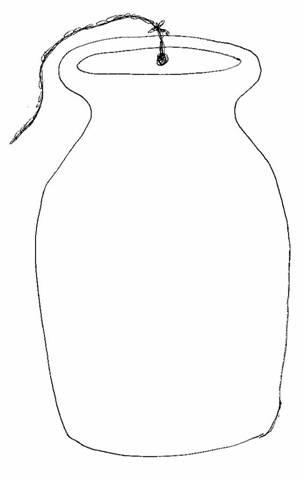
Sermon on the Mount
SERMON ON THE MOUNT

Objectives:
- Students should know that the Sermon on the Mount is full of teachings of Jesus.
- Students should be able to retell the parable of the house on the rock and the sand and explain its meaning.
- Students should memorize the Beatitudes.
Possible Lesson Plan:
- Open with prayer.
- Scripture References: Matthew 5: 1-12 and 7:24-29. All classes are working on the Beatitudes; this class will also focus on the story of the two houses – one built on the rock and one on the sand. There’s a great Arch book about the house on the rock.
- Begin to memorize the Beatitudes. Say or sing it together to begin the memory work to be continued at home. Can each child say it? Go over line by line, reading it to the children:
What is “poor in spirit”? What is the kingdom of heaven like?
When do we mourn? What does God do when we are sad?
Who is meek, or gentle? Does it look like they would inherit the earth?
Do we hunger and thirst after righteousness, really? Are we truly satisfied?
What is mercy? Are we merciful? When? Do we need mercy?
What does “pure in heart” mean?
Who is a peacemaker? What makes them a peacemaker?
What does “persecuted” mean? Have you ever been persecuted for being a Christian?
Has anyone ever told a lie about you? Does it hurt? Did you rejoice?
- Discuss the parable of the two houses. What is the rock? What is the sand?
Which house is easier to build? Picture a storm – what happens to each house? Sing the song:
Don’t build your house on the sandy land.
Don’t build it too near the shore
Well, it might be kinda nice but you’ll have to build it twice.
You’ll have to build your house once more.
You gotta build your house upon the rock.
Make a firm foundation on a solid spot.
Though the storms may come and go.
The peace of God you will know.
- Play a learning game: Bible Bounce. Take a basketball. The leader begins by saying one half of a beatitude, “Blessed are the…” The ball is bounced to a student, who must end the verse, “For…” He then begins a verse and bounces the ball to another student, who must finish the verse.
- Make “Sand Castles”: Before class, make a paste by mixing 2 cup water with 2/3 cup flour and 4 tablespoons sugar. Cook the paste in a saucepan until it turns clear. Cool to room temperature. In class, take a large bowl and add 12 cups sand. Pour in the flour paste and mix with hands until like clay. Let each student make a sand castle. Explain that this is different from the sand in the story in that it will harden. The castles can be painted at home after they dry,
- Too messy? How about a "Beatitudes Teller" instead?
- Close with prayer. Use the Lord’s Prayer, also from the Sermon on the Mount.
Beatitudes Teller
Walking on Water and Calming the Storm
WALKING ON WATER AND CALMING OF STORM
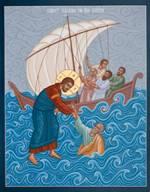 Objectives:
Objectives:
- Students should be able to tell the story of the two miracles in their own words.
- Students should be able to identify Peter as the disciple who walked on water.
Possible Lesson Plan:
- Open with prayer.
- Scripture References: Luke 8: 22-25, John 6: 16-21, Matthew 14:24-33, Mark 4: 36-41, 6:47-52. We have here 2 separate miracles, both involving boat trips. Make 2 columns on your board: “Calming the storm” and “Walking on Water.” Where were the disciples? What was Jesus doing in each case? What was the weather like? How did the disciples feel? How did Jesus respond? Who came walking across the water? Who wanted to walk with Jesus? What happened when Peter looked down? How did Jesus respond?
- Discussion questions: What do we enjoy about good weather? What are some consequences of bad weather? How do we feel in a storm? Has anyone ever seen a truly bad storm? Can we control the weather today with science? What was Jesus trying to teach his disciples when He stilled the storm?
Is it easy to trust God? Peter leaped out of the boat, full of faith. While he kept his eyes on Jesus, what happened? When he looked at the water and thought about the danger, what happened? Look again at “Seek ye first the kingdom of God.” Where should our focus be? Is it?
- Play a learning game: Bible Relay. Divide into 2 teams. Line the teams up at one end of the room, with the referee (teacher) at the other. Teacher should have cards with Scripture references on them (e.g., Luke 8:24, Luke 8:25, John 6:18, John 6:20, Mark 4:40, Mark 6:49, Mark 6:51, Matt.14:28, Matt.14:30, Matt.14:31 . The first player in each team should have a Bible. At a shout of “Go”, the first player in each team runs to the referee, is given a card, and must find the reference. He then reads it to the referee and runs back to his team, giving the Bible to the next player.
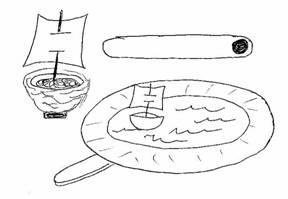
- Make a Sailing Boat: Take a paper plate and color it blue. Make a tiny boat with a half walnut shell (or plastic bottle top), clay or play-doh, a toothpick, and a tiny piece of paper or fabric. Stick a piece of adhesive magnet strip on the bottom of the boat and another on the end of a Popsicle stick. Now use the Popsicle stick below the plate “sea” to make the boat “sail” around.
Close with prayer, asking God to help us trust Him even in a storm.
Feeding the 5000
FEEDING THE 5000
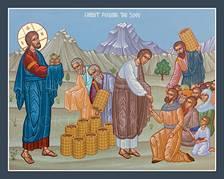
Objectives:
- Students should identify this as a miracle of Jesus.
- Students should know the little boy shared 5 loaves and 2 fishes.
- Students should know that Jesus fed 5000 people after blessing the food and the disciples collected 12 baskets of leftovers.
Possible Lesson Plan:
- Open with prayer.
- Scripture References: Luke 9: 11-17, John 6: 2-14, Mark 6: 32-46, Matthew 14: 13-23. Have pairs of students read each reference and report on the following questions: Why were so many people there? They must have been hungry. What did the disciples want to do? What did Jesus feed them? Where did He get the food? What did Jesus do with it? How many were fed? (Note for the students that only men were counted. Why?) What was left over? Was this a miracle? Why or why not?
- As you continue discussion, serve a small snack of fish (tuna?) and bread (or crackers). Is it tasty?
- Discuss giving: Did the little boy have to share his food? Why did he share? No one forced him to share his food – he wanted to. Jesus teaches us to share food with others. Do you bring lunch or snack to school? What if someone asks for something especially delicious from you? Will you share? Are there other ways we can share besides food? Brainstorm and write them down.
At the word “Go!” students will assume the pose of their choice. Teacher, with eyes closed, chooses one of the words. All with that pose, are “out”. Last student left standing is the winner.
- Play a learning game: Scripture Poses. Choose a pose for each of 3 items in today’s lesson
- Fish: Swimming fish arms with puckered mouth
- Loaf of bread: Hands making small circle like loaf of bread
- Basket: Arms in wide circle like large basket
- Make a Fish and Loaves Plate: Cut out 2 fish and 5 loaves for each student from the patterns. Write on each something the student has said he can share. Bend the tabs and tape to a paper plate, writing on the plate “I Can Share”.
- Close with prayer, asking Jesus to help us to be sharing people, as was the little boy. Pray specifically for the areas the children have said that they are willing to share.
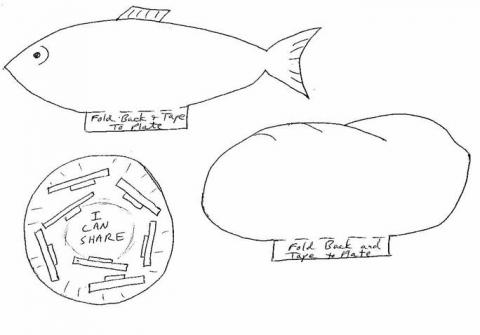 FISHES AND LOAVES PATTERNS
FISHES AND LOAVES PATTERNS
Transfiguration
TRANSFIGURATION
Objectives:
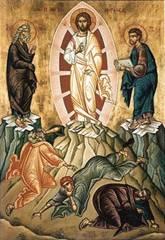 Students should be able to tell the story of the Transfiguration.
Students should be able to tell the story of the Transfiguration.- Students should be able to say the word “transfiguration” and know that it means “Change”.
- Students should be able to identify each character in the icon and his role in the story.
Possible Lesson Plan:
- Open with prayer.
- Scripture References: Luke 9:28-36, Matthew 17:1-13, Mark 9:1-9. Show the icon. Identify all the characters. What does “transfiguration” mean? Who was transfigured? In what way? Who did Jesus speak to? Which disciples came with Him?
- Discussion questions:
In Transfiguration, we see Jesus as both God and man. Is he 2 people? These are the questions of St. Ephraim: If Jesus were not human, who lay in the manger? If He were not God, whom did the angels glorify? If Jesus were not human, whom did Simeon take in his arms? If Jesus were not God, to whom did Simeon say, “Dismiss me in peace”? If Jesus were not human, whom did John baptize? If Jesus were not God, of whom did the Father speak? If Jesus were not human, who took Peter and James and John to the mount? If Jesus were not God, who spoke with Moses and Elijah?
We also see the Trinity at Transfiguration. At which feast was the triune nature of God (3 persons in 1 God) first revealed? (Theophany) Why doesn’t the Holy Spirit keep the same form on Mt. Tabor (What? luminous cloud) as at the Jordan (What? dove) or at Pentecost (What? tongues of fire)? It would be easier to recognize him if He would. Jesus always appears as a man since the Incarnation. But, the Spirit is not incarnate in the dove or the fire or the cloud; “He is everywhere and fills all things”.
The Transfiguration of our Lord occurred forty days before He was crucified. Remember some other important 40s in the Bible – 40 years in the wilderness for the children of Israel and 40 days in the wilderness being tempted for our Lord? With His Transfiguration, our Lord strengthened the faith of his disciples and helped prepare them for His coming crucifixion. Knowing His divinity, they could understand that His suffering was of His own free will.
- Historical Background: Review the Old Testament stories of Moses and Elijah. Why would God have chosen these two men for Jesus to speak to? What was their importance in the Jewish history? Both are considered to be forerunners of Jesus. Many people thought that John the Baptist was Elijah come back to life. How was John like Elijah? How was Jesus like Elijah? How was Jesus like Moses? But, even more important, Jesus was clearly greater than these great prophets, not one of them – an important understanding for the disciples.
- The Feast of theTransfiguration is celebrated on August 6. We bring fruit to church on the feast. Why? We are asking God to bless the harvest of fruit and the crops, which are just becoming ripe at this time. Clusters of grapes, ripe in Greece and in Palestine at about the time of the feast, are especially symbolic. What is made from grapes? (wine) Where does our Lord have us use wine each and every Liturgy? (the Eucharist) Why do the Russians bless apples at this time? (the climate is too cold for grapes!)
- Play a learning game: Guessing Game. Divide the class into 2 teams. Each team should have a captain as spokesperson. Both teams listen as the scorekeeper (teacher) reads a description of a character from the lesson (Jesus, Peter, James, John, Moses, Elijah, John the Baptist). Try for a long description, beginning with trivia (This person is a man. He has a beard…) and saving the critical facts for the end. The captain should stand when his team knows who it is. If right, that team gets the point.
- Make a Transfiguration Diorama. Use pipe-cleaners with a little clay on the bottom for figures. Draw your background on a piece of paper and glue into a shoebox or similar-size container. Green felt makes nice grass on the bottom. What are the figures carrying? Make clothing, if desired, of small bits of felt or cloth. Construction paper will do nicely for “props”.

- Close with prayer. Ask God to bless the fruit and crops now and every year.
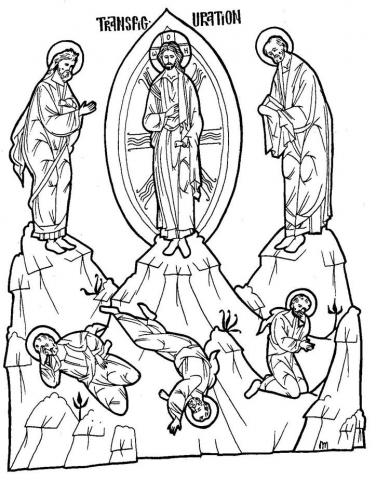
Good Samaritan
THE GOOD SAMARITAN
 Objectives:
Objectives:
- Students should be able to identify this story as a parable of Jesus.
- Students should be able to tell the story in their own words.
- Students should have an understanding of what makes a good neighbor.
Possible Lesson Plan:
- Open with prayer. Use the Lord’s Prayer. Recite it a couple of times for memory practice.
- Scripture Reference: Luke 10:25-37. Review the meaning of a parable, a story with a hidden meaning. Jesus told this story to answer a question – what was the question? Who asked it and why? Where did the merchant come from; where was he going? What happened to the man in the story? How many people passed by? Why did they pass by? Why did the Samaritan stop? What did he do? Was the Samaritan man a good neighbor to the hurt man? Why?
- Discuss the concept of “neighbor”: Ask the children who are their neighbors. After a listing of friends and neighbors, try to expand their focus. Is the homeless man in the street who smells bad and is dirty also a neighbor? Is the child who steals their lunch money also a neighbor? Is the boy who hits them on the playground also a neighbor? Did Jewish people usually like Samaritans? Did Samaritans usually like Jewish people? Remind the children that the Samaritans were the descendants of the people who were not taken into Babylon in captivity; they married people of the land and were hated by the Jews when they returned. Was it easy for this Samaritan man to care for the Jewish man? Is it always easy to love other people and to do good things for them? Is there someone you find particularly difficult to love? Can you do something nice for them as a good neighbor?
- Play a learning game: Pass the Ball. Sit in a circle. The leader holds a small ball. He begins the story of the Good Samaritan with one line and passes the ball to the next player. This person must continue the story with one line. And so around the circle as many times as needed to finish the story.
 Make an Envelope Viewer Movie Strip. Cut a TV screen hole in the front of a business-size envelope. Lick the envelope shut and cut off both ends. Give each student a strip of paper divided comic-strip style into about 6 frames. Have them illustrate the story of the Good Samaritan; what are the most important scenes? Insert the strip in the viewer and pull through to see the whole story. Can they tell the story with their “movie”?
Make an Envelope Viewer Movie Strip. Cut a TV screen hole in the front of a business-size envelope. Lick the envelope shut and cut off both ends. Give each student a strip of paper divided comic-strip style into about 6 frames. Have them illustrate the story of the Good Samaritan; what are the most important scenes? Insert the strip in the viewer and pull through to see the whole story. Can they tell the story with their “movie”?- Close with prayer. Have each child think of a particular person who is hard to love and pray for that person and plan something nice for that person.
Parable of the Sower
PARABLE OF THE SOWER
Objectives:
- Students should be able to tell the story of the parable in their own words.
- Students should know the word, “parable”, and be able to say that it is a story with a hidden meaning.
- Students should know the “hidden meaning” of the seeds and the sower.
Possible Lesson Plan:
- Open with prayer.
- Scripture References: Mark 4:1-20 and Luke 8:5-15. What is a parable? In this parable, who is the sower? What are the seeds? What is the soil?
- Try to understand the parable a bit: What kind of people are hard, rocky ground? Would seeds grow well there? What kind of people are easily dried out by the hot sun? Would seeds grow well there? What kind of people are so shallow the birds can eat the seeds? What kind of things might be thorns that take over our lives? What kind of people are rich soil? What kind of people are each of us? Are we always the same soil, or sometimes richer? What can we do to make our own soil more fertile for the teachings of Jesus?
- Play a learning game: “A Missing Part”. Select enough verses from the story in either Mark or Luke that every pair of students will have a verse. Write each verse on a piece of paper. Tear the paper in half. Give each student a half sheet. Students must find the student with the other half of the verse. They then sit down together. When all are seated, have each pair read the entire verse; this can be really funny if each student reads only from his half!
- Make a Seed Starter Station: Take an egg carton, preferably paper. Fill with soil. Plant various seeds in the different pockets, or try to do an experiment based on the parable – two pockets with only rocks, two with almost no soil, another 2 with lots of weed seeds (e.g. grass), and the rest with deep soil and pretty flower seeds. Have the children take their “science experiment” home, water it, and watch the growth.
- Close with prayer, asking Jesus to make us good soil to learn and obey His teachings.
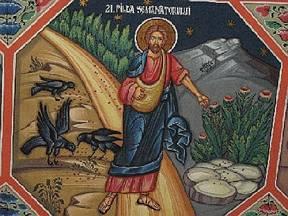
Zaccheus
ZACCHEUS
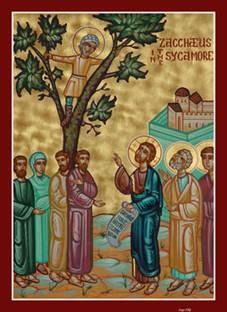 Objectives:
Objectives:
- Students should be able to identify Zaccheus as the short man who wanted to see Jesus.
- Students should know how Zaccheus’s life was changed by meeting Jesus.
Possible Lesson Plan:
- Open with prayer.
- Scripture Reference: Luke 19:1-10. What did Zaccheus do for a living? Do we know another tax collector in the Bible? (Matthew, the disciple) Why couldn’t Zaccheus see Jesus? What did he do? What did Jesus say to Zaccheus? What did Zaccheus do for Jesus?
- Discussion: Jesus was a famous man; people from all over came to see Him. Why? Have students list several reasons why people would want to see Jesus. (to be healed, to hear His teachings, to see a miracle, just to say they saw Him) Zaccheus lived in Jericho, the City of Palms. Find Jericho on your maps. He heard that Jesus would be coming to town. Zaccheus was rich; he was the chief tax collector. Remember that tax collectors collected exorbitant taxes and kept the extra. Was Zaccheus popular? Do you think he had many friends? Make 2 columns on your board: “Things money can buy” and “Things money can’t buy.” Brainstorm to fill the lists. Zaccheus could have all he wanted in the first column. What about the second? Do we sometimes think that we’d be happy if only we had everything that money could buy? Was Zaccheus a happy man? Why do you think Zaccheus wanted to see Jesus? How did Jesus respond? How did Zaccheus’s visit with Jesus change him?
- Play a learning game: Musical Bridge. This is played as a cross between musical chairs and London Bridge. The teacher and one student form the bridge. The rest line up and circle while singing “Zaccheus was a wee little man…” Whoever the bridge catches at the end of the song must answer a question about Zaccheus. If he answers correctly, he gets to become part of the bridge. Sample questions might be:
What did Zaccheus do for a living? What did Jesus say to Zaccheus?
Where did Zaccheus live? Where did Jesus have supper?
Was Zaccheus tall or short? How much did Zaccheus give to the poor?
What kind of tree did Zaccheus climb?
- Make Popsicle Puppets: Take the Zaccheus and the Jesus patterns. Color and cut out. Tape Popsicle stick to the back. Have students take a piece of light blue construction paper. Cut out a brown tree trunk and green leaves. Glue to make a tree. Use this as your background to tell the story with your puppets.
6. Print the Pre-Lenten Path for the children to take home and color one square each day until Great Lent.
- Close with Prayer.
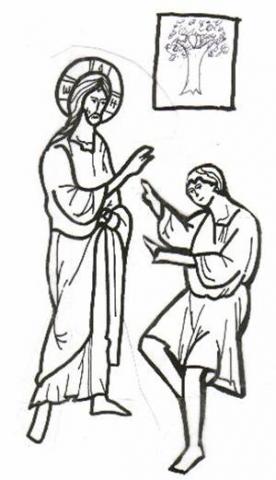
Publican and Pharisee
THE PUBLICAN AND THE PHARISEE
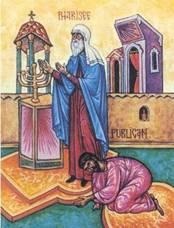
Objectives:
- Students should be able to say the words “publican” and “Pharisee” and know their meanings.
- Students should know whose prayers God listened to and why.
Possible Lesson Plan:
- Open with prayer.
- Scripture Reference: Luke 18:9-14. What is a publican? Who else have we met who is a tax collector? (Zaccheus and Matthew) Review their stories briefly. What did the publican pray? What is a Pharisee? (a respected man of the temple) What did he pray? Which did God listen to? Why?
- Talk a bit about humility: How do you feel when you win a race? Get a prize? Do something good? This feeling is called pride. Some pride is OK. But the Pharisee had done many good things – so many good things that he was always bragging about himself, even to God! Do you ever brag when you do something good? How does it make you feel? How does it make other people feel? Do you feel like you’re better than other people? Does it look that way when you brag? Did the Pharisee think he was better than the publican? Was he in God’s eyes? Have you ever done anything wrong – ever disobeyed God or your parents, cheated in school, hit your brother, yelled at your sister, etc.? None of us is perfect; we all make mistakes. When we pray, should we brag, or should we ask God to help us obey Him even better? Remember the Beatitudes: can anyone recite “Blessed are the poor in spirit…”? Which was poor in spirit – the publican or the Pharisee? Which will inherit the kingdom of heaven?
- Play a learning game: Publican Says. Line the students up along the wall. Tell them that they will hear a line of a possible prayer, followed by a command. If the prayer would have been that of the publican, they should follow the command, just like in “Simon Says”. But if it’s the Pharisee’s line, they should not follow the command. Of course, just as in Simon Says, the student is “out” if he does the wrong thing. Sample lines (mix them up):
Pharisee: God I thank thee that I am not like other people; touch your toe
I fast twice a week; rub your nose.
I pay tithes of all I get; shake your head.
I am a wonderful man; stand on one foot.
Publican: God be merciful to me; touch your eye.
I am a sinner; rub your stomach.
I am not worthy to be called your son; touch your elbow.
I cannot even lift my eyes to heaven; wave your hand.
- Make an Judgment Tile: Take a 4-6 inch tile or wooden plaque or cut from cardboard. Cut circles from tinfoil for the central mirror, or buy small mirrors. Add the lettering around the mirror and have students decorate with sequins, glitter glue, etc. Apply adhesive magnet strips to the back to hang on the refrigerator.
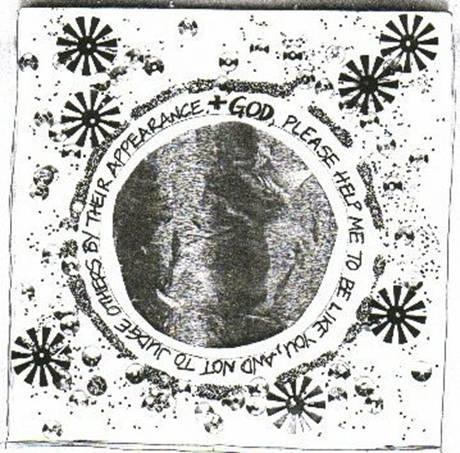
Close with prayer.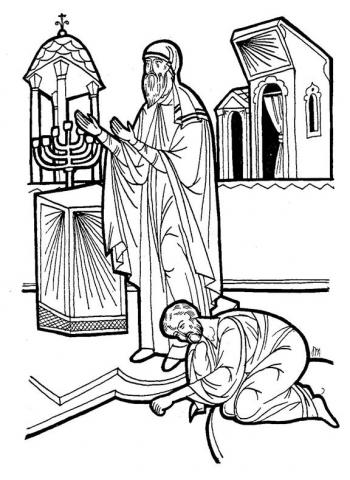
Prodigal Son
THE PRODIGAL SON
 Objectives:
Objectives:
- Students should be able to tell the story of the Prodigal Son in their own words.
- Students should know that God forgives us even when we do something we shouldn’t.
Possible Lesson Plan:
- Open with prayer.
- Scripture Reference: Luke 15: 11-32. Where did the son go? What did he do with his money? Where did he end up, doing what? Why did he go back to his father? What did he say? What did his father say? Let’s look a bit at the older brother. He stayed at home, obedient. Where was he when the younger brother returned? What did he hear as he approached the house? How did he feel about all the celebration? Why? What did the father do when the older brother wouldn’t come to the party? What did the father say? How did the brother respond?
- Play a learning game: Word Jumble. Give each student a pad and pencil. Have your chalkboard or large tablet ready. Ask the question and then write the scrambled answer on the board. Give the students 30-60 seconds to write their answer on their tablet and go on to the next question:
(1) I was supposed to be given away when the THENECIARNI
father died. What am I?
(2) I left my family to go to the city. Who am I? GRAPOLID SNO
(3) I am a shortage of food. What am I? MEFNIA
(4) I gave the prodigal son a job. Who am I? GPI NOREW
(5) I was given to the prodigal son when he GIRN
returned. What am I?
(6) I forgave the prodigal son. Who am I? SHE TREAFH
(7) I did not waste my inheritance. Who am I? DOREL OSN
(8) I was called on to prepare a feast. Who am I? NEVSTAR
- Talk a bit about the words “I’m sorry”: These are powerful words. When do we say them? Have the children think of some times they have said them or heard someone else say them. What do we mean by saying “I’m sorry”? Did the Prodigal Son say, “I’m sorry”? How did the father respond? How do we respond when someone says they are sorry? Sometimes it’s not so easy to forgive. What if your friend broke your favorite toy and said, “I’m sorry”? Is it easy to forgive when the toy is still broken?
- Take a pigpen pledge: Review the story. The Prodigal Son was in the pigpen. He realized his sin and his father’s love – then he had to take a step. He had to get up and leave the pigpen and take a step towards his father! Picture this with the students. Then have each in preparation for Lent consider his or her own pigpen. What one single step can he or she take during Great Lent to move towards the Lord? Increased prayer time? Scripture reading each day? Lenten services? Improved fasting? Visiting the sick? Let each student actually write down the step he will take to draw nearer to the Father.
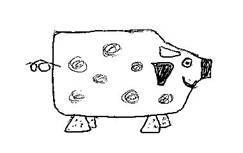 Make a Piggy Bank: The teacher should make one, too, to be the class piggy bank. Take a gallon milk or juice plastic container. Turn it on its side so the handle is on top. Glue eyes just below the handle on both sides, 4 corks or bottle tops for feet, pink felt ears, and paper circles for spots all over the pig’s body. Twist a pipe-cleaner into a tail and poke it into the plastic behind. Draw on a mouth. Finally, cut a slit in the top for coins. All during Great Lent, we will each collect coins at home (from the sofa cushions, off the floor, by doing chores, etc.) and will bring them in to class to put in the class Piggy Bank to give to the IOCC at Pascha.
Make a Piggy Bank: The teacher should make one, too, to be the class piggy bank. Take a gallon milk or juice plastic container. Turn it on its side so the handle is on top. Glue eyes just below the handle on both sides, 4 corks or bottle tops for feet, pink felt ears, and paper circles for spots all over the pig’s body. Twist a pipe-cleaner into a tail and poke it into the plastic behind. Draw on a mouth. Finally, cut a slit in the top for coins. All during Great Lent, we will each collect coins at home (from the sofa cushions, off the floor, by doing chores, etc.) and will bring them in to class to put in the class Piggy Bank to give to the IOCC at Pascha.
- Close with prayer. Pray for each student to be faithful in his steps from the pigpen to the Father.
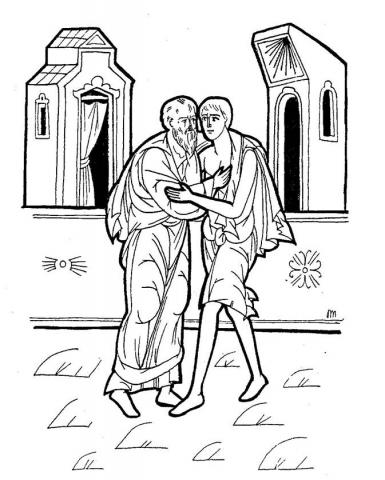
Last Judgment
THE LAST JUDGMENT
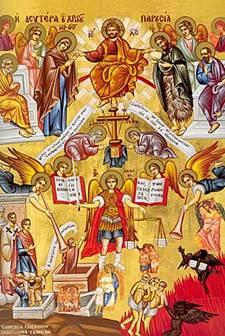
Objectives:
- Students should know that Jesus is coming again as judge.
- Students should be able to list some of the characteristics of goodness.
Possible Lesson Plan:
- Open with prayer.
- Matthew 25:31-46. Have the children try to list the characteristics of goodness, as stated in the parable, under the heading of “sheep”. What’s a parable? What’s the difference between sheep and goats?
- Review some Old Testament stories of judgment: Adam and Eve and the Garden, Noah and the flood, Sodom and Gomorrah and Lot’s wife, Pharaoh and the plagues of Egypt, etc. Each of these can be looked at again.
- Discussion: Begin with your headings under sheep on the board. Make columns under each heading and brainstorm for specific ways that we can personally fulfill that characteristic. For example: under food – homeless bags, under clothing – give to Goodwill. Be sure there are several choices for each heading – actions that are feasible for this age group. Then, have the students commit to doing one of these things each day during Great Lent. Pass out copies of calendars as Lenten diaries to write down the action on each day.
- Play a learning game: Finish the Verse. Print the first and last halves of each verse on separate cards. For example:
I was hungry You gave Me something to eat.
I was thirsty You gave Me drink
I was a stranger You invited Me in
I was naked You clothed Me
I was in prison You came to Me
Give each student a card. At “Go”, each must find his other half. The pair then sit down together. When all are paired, have each team read the entire verse.
- Make a Last Judgment Projector: Take a paper towel tube. Cut off about 1 inch at one end. Tape 2 popsicle sticks nearly side-by-side to hold the 2 pieces of tube together with a ¼ inch slit between. Take a long-thin strip of paper divided comic-strip style into 8 sections. In the first, have the student draw a sheep and in the last, a goat. In each of the other sections, draw one of the specific actions called for in the parable. Insert the paper into the “projector”, hold up to the light, and watch your Last Judgment movie.
- Close with prayer. Have each child specifically select a Last Judgment good deed to do this week.
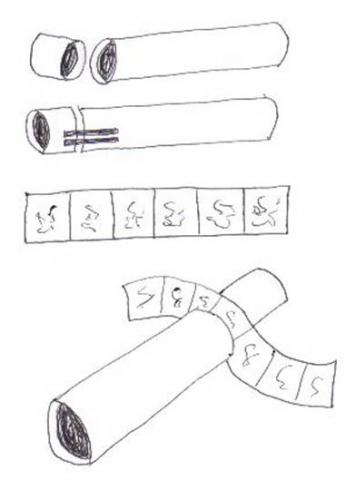
Forgiveness and the Paralytic
FORGIVENESS/ THE PARALYTIC
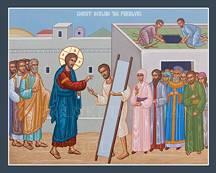
Objectives:
- Students should be able to tell the story of the paralytic and his four friends.
- Students should know that Jesus can forgive sins because He is God.
- Students should know that we receive forgiveness from God through Confession and from each other on Forgiveness Sunday.
Possible Lesson Plan:
- Open with prayer.
- Scripture References: Luke 5: 17-26, Matthew 9:1-8, Mark 2:1-12. What does “paralytic” mean? Where was Jesus? Where were the friends with the man? How did they get into the house? What did Jesus do? Say? What happened? How do you think the man felt? His friends?
- Who forgives sins? Jesus said something unusual to the paralytic before he healed him. What did He say? The paralytic hoped for healing for his body. But Jesus first healed his soul. The Prodigal Son asked for forgiveness; did the paralytic? Tonight, in church, we’ll be celebrating Forgiveness Sunday. We’ll go from one to another asking forgiveness and being forgiven. Remind the students how the service will proceed and have them pair up to practice. But, only one person can forgive us all our sins. Who is that? When Jesus told the paralytic that his sins were forgiven, Jesus was claiming to be Whom? And, when the paralytic walked, Jesus proved that He was indeed God!
Through which of our Sacraments do we receive forgiveness from God?
(Confession) Why can’t we just confess in secret to God? (What about that pervasive self-deceiving psychological trick, denial, and accountability?) Who does the priest represent? (Christ) Did Jesus have the authority to forgive sin? (Consider the healing of the paralytic) What was the practice of the earliest Christians? (They actually stood up before the whole congregation and confessed their sins, truly walking in the light.) Why did this practice end and priests begin to hear confession privately? (Strangers coming to visit as the Church grew in numbers made public confession difficult.)
- Play a learning game: Charades. Write the names of several miracles we have already studied on slips of paper – Feeding the 5000, walking on water, quieting the storm, water into wine, paralytic, transfiguration. Each student in turn should choose a paper and act out the miracle so the others can guess what it is.
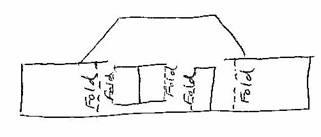 Make a Stand-up House and add the paralytic, Jesus, and his friends. The house is easily made with a long sheet of construction paper. Cut out window and door, folding to open. Cut out the figures and color them. Glue or tape the friends to the roof, each one holding a string that attaches to one corner of a piece of felt for the stretcher of the paralytic. The strings should be just long enough that the paralytic, lying on his “stretcher” is visible in the window. Glue Jesus in the doorway.
Make a Stand-up House and add the paralytic, Jesus, and his friends. The house is easily made with a long sheet of construction paper. Cut out window and door, folding to open. Cut out the figures and color them. Glue or tape the friends to the roof, each one holding a string that attaches to one corner of a piece of felt for the stretcher of the paralytic. The strings should be just long enough that the paralytic, lying on his “stretcher” is visible in the window. Glue Jesus in the doorway.
6. We are now entering Lent. Use the Lenten Path to trace your journey through the season.
7. Close with prayer.
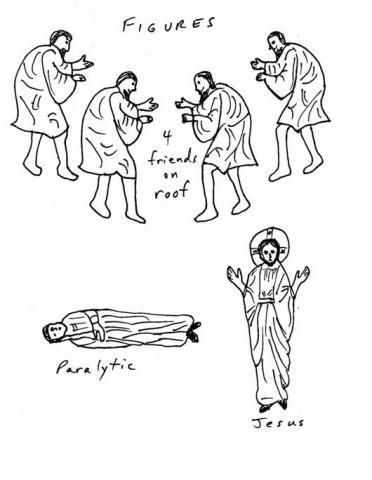
Miracles and Healings
MIRACLES AND HEALINGS
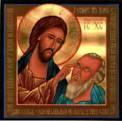 Objectives:
Objectives:
- Students should be able to tell the story of at least one healing of Jesus.
- Students should know the word “miracle” and what it means.
- Students should know that we access the healing power of Jesus through the Sacrament of Holy Unction.
Possible Lesson Plan:
- Open with prayer.
- Scripture References: Assign a Scripture or two to each student, to read and report to the class:
Mark 5:22-24, 35-43 Mark 3:1-5
Luke 7:2-10 John 9:6-9, 24-25
Mark 7:32-37 Luke 13:11-13
Mark 1:30-31 John 4:46-53
Luke 17:12-19 Luke 22:50-51
Mark 9:17-29 Mark 10:46-52
Mark 8:22-26 John 5:5-15
What kinds of problems did Jesus heal? What kinds of people did Jesus heal? Did He heal the same way each time?
- Discussion: The Church has a special sacrament where we pray for healing. It is called “Holy Unction.” Can Jesus really heal the sick? Are there miracles today? Didn’t Jesus have to touch the person to heal him? (No, remember the Roman centurion’s servant) Aren’t miracles really superstition? How does the sacrament of Holy Unction differ from say a rain dance by the pagans? Don’t we have doctors now we can go to if we are sick? Why doesn’t Jesus heal everyone? Why do we get sick at all? Aren’t we all going to die anyway? Should we only call for Holy Unction when we are dying? (no) In what other ways can we as Christians serve those who are ill, especially those who are chronically ill?
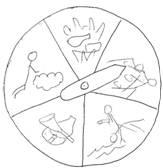 Play a learning game: Bible Headlines. Assign a miracle to each student. Have the students come up with a catchy headline for their miracle. After a few minutes, have the students one by one present their headline. Can the others guess the miracle?
Play a learning game: Bible Headlines. Assign a miracle to each student. Have the students come up with a catchy headline for their miracle. After a few minutes, have the students one by one present their headline. Can the others guess the miracle?
- Make a Story Spinner: Take a paper plate. Divide it into a section for each miracle discussed today, at least 4 and no more than 6. Have students draw a picture of the miracle in the wedge-shaped section of the plate. Use an arrow cut from poster board (or another plate) and a brad to make a spinner. Can the student spin the spinner and tell whichever story it lands on?
- Close with prayer, praying especially for anyone known by a student to be sick.
Lazarus
THE RAISING OF LAZARUS
Objectives:
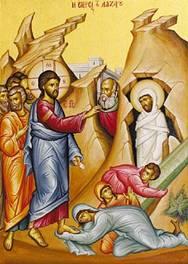 Students should be able to tell the story of Lazarus in their own words.
Students should be able to tell the story of Lazarus in their own words.- Students should know the names of Mary, Martha, and Lazarus.
Possible Lesson Plan:
- Open with prayer. Consider making Lazarakia, which need to be started at the beginning of the lesson to be able to bake. Make the dough ahead of time so the children can shape, rise, bake, and eat. You can shape them before the lesson. Recipe:
1 ¾ cups lukewarm water, 1 tbsp yeast, 1 cup sugar – Mix in bowl until yeast bubbles
Add: 1/4 cup olive oil, 1 tsp cinnamon, 1 tsp ground cardamom, 1/4 tsp salt, 5 ¼ cups flour
Knead ahead of time and allow to rise till doubled. Punch down. Then, give children a piece about the size of a golf ball. Flatten and add filling of either chocolate chips or chopped walnuts and raisins. Fold over and pinch closed to make an oval with seam side down. Take a smaller piece and make a long snake. Wrap around from the back like arms and cross in the front. Insert 2 whole cloves for eyes. Place on baking sheet with parchment paper labeled with child’s name. Allow to rise till doubled and brush with sugar water and bake at 325 degree oven until golden brown.
2. Scripture Reference: John 11. Where was Jesus when Lazarus became sick? Who were the sisters of Lazarus? How was Lazarus by the time Jesus came? What did Jesus do? Why did Jesus cry? What happened to Lazarus after Jesus prayed? Review the story with the icon, identifying Jesus, Lazarus, Peter, and the sister.
- Discussion: Was this the first person Jesus raised from the dead? (No, the son of the widow of Nain and the daughter of Jairus, but both had just died; they had not been dead for 4 days) Why is the 4 days important; why did Lazarus “already smell”? (The 4 days show true corruption, the rottenness inside us all, defeated by Jesus in the tomb, since He alone is without corruption or sin) Who did Jesus say that He was to Martha? (I am the resurrection…) What’s the shortest verse in the Bible? (piece of trivia, “Jesus wept.”) Why did Jesus weep? (because God truly cares, He is the Lover of Mankind)
- Play a learning game: The Big Step. Players line up along one wall. The opposite wall is the finish line. Teacher asks each player a question about today’s lesson in turn. If the player gives the correct answer, he can advance one giant step toward the goal. If not, next player gets a chance with the same question. First player to the opposite wall is the winner.
- Make the Holy Cross News: Take a newspaper. Have the students cut out words to form the headline they would write if they were reporting on the miraculous event of Lazarus’s resurrection. Glue the words onto a piece of paper and roll into a scroll, tying with a ribbon.
- Another Craft option: Jesus tells Mary and Martha here that He is the Resurrection and the Life. Make an "I am" wheel with many of Jesus's statements about Himself. Print the templates on cardstock, or on regular paper and glue to paper plates, color, cut out the one section, and use a brad to put the colored crosses over the names. Spin to see the names of our Lord.
- Begin your Lenten Journey Calendar, printing on cardstock for each student. This was adapted for Orthodoxy from the Catholic Icing Website. Mark off or color in the days already past and take home to continue to count down to Holy Week and Pascha.
- Close with prayer.
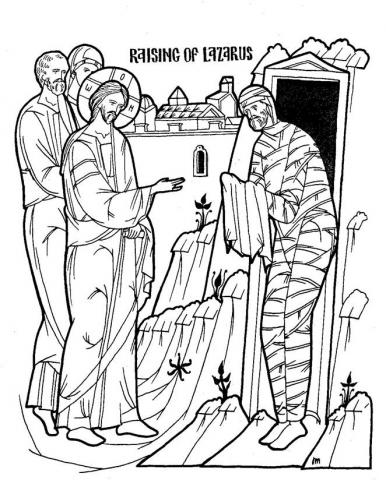
Palm Sunday
PALM SUNDAY
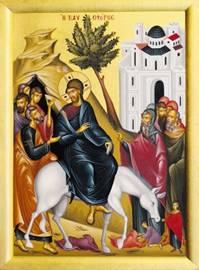
Objectives:
- Students should be able to identify the characters and the action in the icon.
- Students should know why we use palms on Palm Sunday.
- Students should know that Palm Sunday is the day after Lazarus Saturday and the week before Pascha. Why?
Possible Lesson Plan:
- Open with prayer.
- The icon: What do the students already know? Christ the central figure, seated on a donkey (Why a donkey?), the disciples on the far left and the Jews on the far right, the children (one in a tree cutting palm branches and one spreading his cloak under Christ), the city of Jerusalem with the Temple with its onion dome.
- Scripture readings: Matthew 21:1-11, 15-17, John 12:1-18
- Songs of the Feast:
Troparion: By raising Lazarus from the dead before thy passion, thou didst confirm the universal resurrection, O Christ God. Like the children with the palms of victory, we cry out to thee, O Vanquisher of death: Hosanna in the highest, Blessed is He that comes in the name of the Lord.
- Discussion questions:
How did the resurrection of Lazarus effect the response of the crowd on Palm Sunday? Explain the Troparion in your own words; the same Troparion is used for Lazarus Saturday and Palm Sunday, why? What did Jesus show the world? (that God’s power is greater than death) Did Jesus enter Jerusalem on a warhorse surrounded with an army? Why not? (He came to bring His love, coming on a peaceful donkey) What was the significance of the donkey? Whose prophecy was being fulfilled? (Zechariah) How’d he get the donkey?
What does “Hosanna” mean? (“I ask you to save me”) Where did the greeting the people gave Jesus on Palm Sunday come from? (Psalm 118: 25-26) Thus Jesus is being recognized as King. What is the significance of the greeting, “Son of David”? (Jesus is recognized as Messiah.) Review the story of David and God’s promise to David that His Messiah would be David’s descendant. Did Jesus sneak into the city, afraid of its leaders since He knew what they would do to him only a few days later? What would you have done in that situation? Does the raising of Lazarus and the triumphal entry into Jerusalem have any effect on the priests who will later condemn Jesus? (It is because of these and the response of the people, that He was judged and condemned.) What is the significance on Palm Sunday of Jesus’s reddish garments? (From Genesis 49: represent blood) Remember that with our palms of joy we are also called to suffering and death; we cannot have the one without the other!
- How does our Church celebrate Palm Sunday? (procession, palms, pussy willows) What is the significance of these customs?
- Play a learning game: Final Jeopardy. Give each student a pad of paper and a pencil. Prepare your “answers” ahead of time – e.g. donkey, Hosanna, Jerusalem, Lazarus, etc. Give the answer and each student should write an appropriate question on h
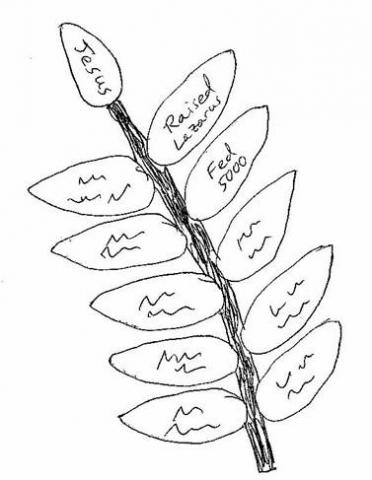 is pad. After 30 seconds, hold up the questions and compare.
is pad. After 30 seconds, hold up the questions and compare.
- Make a Jesus Palm Branch: Cut lots of green construction paper leaves. Have the students brainstorm things that Jesus did or said and write each on a leaf. Using a thin dowel for the stem, tape the leaves on the sides to make a palm branch.
- Close with prayer.
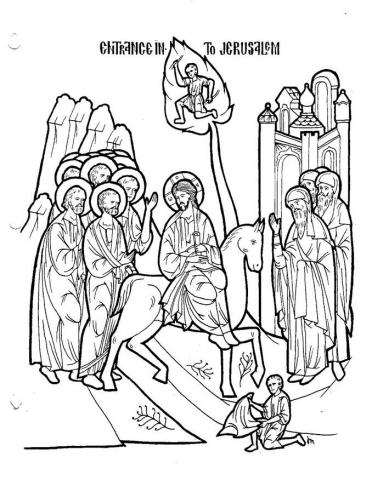
Last Supper
THE LAST SUPPER
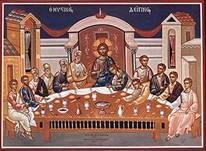 Objectives:
Objectives:
- Students should be able to tell the story of the Last Supper in their own words.
- Students should identify the major figures in the icon.
- Students should know that the Last Supper was also the first Communion.
Possible Lesson Plan:
- Open with prayer.
- Scripture References: Matthew 26: 17-75, Mark 14:12-72, Luke 22:1-65, John 13 and 18:1-27. Each gospel writer wrote what he (or his source) observed. Divide the class into 4 groups and have each group spend about 5 minutes reading one of the gospels above. Then, make a timeline on the board. Beginning with Matthew, have each group fill in the events recorded in its reading to get a complete view of this important event. Then, review the story with the icon, identifying the characters, the bread, and the wine. We celebrate the Last Supper on Holy Thursday with the 12 readings of the story.
- Historical background: Review the story of Passover in Exodus 12:1-13. Jesus and His disciples were celebrating Passover dinner in accordance with the Law of Moses at the time of the Last Supper. In fact, Jesus is called the Paschal lamb. How is He like the Passover lamb? The lamb saved God’s people from death, just as Jesus was soon to save all people from death.
- At the Last Supper, Jesus instituted the Sacrament of the Eucharist. Why do we celebrate the Eucharist? Are they truly His body and blood or only a symbol? How do they become His body and blood? (a mystery!)
- Play a learning game: 20 Questions. Write the names of the significant people from today’s lesson on small slips of paper – Jesus, Peter, John, Judas, man with jar, Moses, Pharaoh, Caiaphas, high priest’s slave, servant girl at the fire, rooster. Each student in turn can select a paper. The others must identify the character by asking yes or no questions.
- Egg Carton Last Supper: Print the icon full page size, preferably on cardstock. Leave bottom intact, but cut around the top bodies of all the figures around the table, especially the two on the ends, cutting them down to their hands on the table. Discard the background, leaving figures and table. Cut the top off an egg carton. Then cut the bottom in half lengthwise. Cut off the two end sections, leaving 4 sections. Place upside down. Glue table legs to what is now the front, and table top to the 4 egg cups. Bend the figures up.
- Bake Prosphora to use during Holy Week: Tell the students that this is the bread that Father uses for Communion. It would be best to mix the dough at home:
3 cups warm water Mix warm water and yeast
2 tablespoons fast rise yeast first
5 pounds bread flour Add flour, salt, and cool
3 cups cool water water and knead.
1 ½ tablespoons salt
Let the dough rise during Liturgy in the kitchen (not in oven). Divide into a loaf for each child and let the children knead and shape the loaves and stamp them. Take them home again to bake. Help each child to make a list of relatives, living and dead, for Father to pray for.
8. Close with prayer.
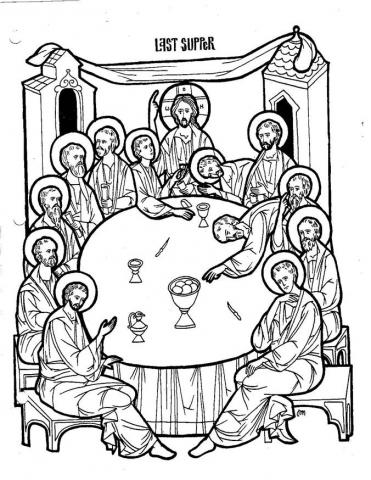
Crucifixion
THE CRUCIFIXION
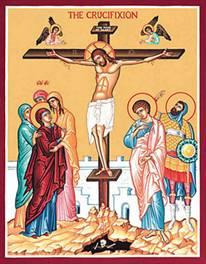
Objectives:
- Students should know the story of Jesus’s arrest, trial, crucifixion, and burial and be able to tell it in their own words.
- Students should be able to identify the characters in the icon and their meaning.
- Why is the cross the universal symbol of Christianity?
Possible Lesson Plan:
- Open with prayer.
- Scripture References: Matthew 27, Mark 15, Luke 23, John 18-19. Again, divide into 4 groups, each reading one gospel. Report to the rest of the group. Draw a large time-line on the board and fill in the events of Holy Friday. Where was Jesus when He was arrested? What was He doing? What were the disciples doing? How did Judas betray Him? Peter lied about knowing Jesus how many times? Before when? Who was the high priest? The soldiers put what on Jesus? Who condemned Jesus to death? How did He die? Who carried the cross? Why? What are some of the things Jesus said on the cross before He died? Who was crucified with Jesus? What happened when Jesus died? Who took Jesus’s body to his own tomb? Review the story with the icon, identifying the people. What role did each play?
- We celebrate the Crucifixion on Holy Friday. We sing on Thursday about the “Wise Thief”. Which thief was wise and why? We also sing on Friday about “The Noble Joseph”. Who was the noble Joseph? What did he do? Play these beautiful songs if you want with tape or CD from the bookstore. Do you remember what we do in Church on Holy Friday? (Procession, candles, the tomb.)
- Review the major players: Jesus, the 12 disciples (who were they?), myrrh-bearing women (though they haven’t brought the myrrh year, who will they be?), the Pharisees (a group of religious leaders of the Jews particularly devoted to the Torah), the Sadducees (a wealthy priestly aristocracy, concerned with Temple administration and ritual), the scribes (educated civil servants), the Sanhedrin (a senate of 70 priests and laymen, presided over by the high priest), Caiaphas the High Priest, Pontius Pilate the Roman governor, Herod the King, Barabbas the condemned murderer, the 2 thieves, the centurion (the same one who had early sough Jesus out for healing of his servant according to tradition), and Joseph of Arimathea (a wealthy follower of Jesus and member of the Sanhedrin, “the noble Joseph”).
- Make a Holy Week game. Along the lines of chutes and ladders, draw a gameboard. Fill in events of Holy Week along the path, with a penalty (chute) for the bad events (betrayed by Judas, condemned by Pilate, crucified, buried by Joseph of Arimathea, etc.) and a reward (ladder) for the good events (Palm Sunday, washed disciples’ feet, prayed in Garden of Gethsemane, etc.) Have the children choose the most important events from their time line or cards to include on their game board and place them in order. Use dice to play the game; no dice? Tear 6 strips of paper and write a number from 1-6 on each and draw a paper when it’s your turn.
- Try a Holy Week Scavenger Hunt.
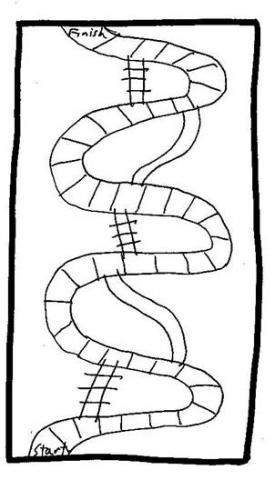
- Close with prayer. Sing “Before Thy Cross” and practice the sign of the cross. What do the 3 fingers represent? The other 2 fingers?
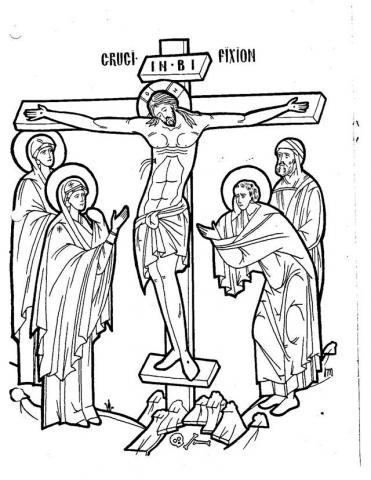
Pascha
PASCHA
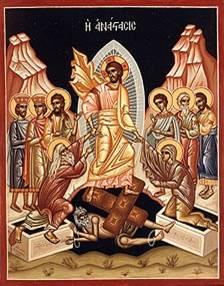 Objectives:
Objectives:
- Students should understand the icon, its characters and its significance.
- Students should know the Troparion of the feast and “Christ is risen…”
- Students should know the Paschal greeting and response, preferably in several languages.
Possible Lesson Plan:
- Open with prayer.
2. The icon: again begin with its review and discussion. Christ is the central figure, robed in white (Why?) surrounded by light (Why?), at His feet are the brass gates of Hades, the keys, and the locks that He destroyed. Adam is being pulled from his tomb by Christ with His right hand and Eve with His left. The righteous from the Old Testament gather on the left; the 2 in the front are Kings David and Solomon. The righteous from the New Testament are those on the right, those who died after the Incarnation and before the resurrection; in front we find St. John the Baptist and St. Joseph. See if the students remember the stories of each of these characters.
- Scripture references: Matthew 28, Mark 16, Luke 24, John 20. Again divide into 4 groups, each reporting on its gospel to the class.
- Service References: Sing them!
Troparion: Thy resurrection, O Christ our Savior, the angel in heaven sing, enable us on earth to glorify thee in purity of heart.
Another Troparion: Christ is risen from the dead, trampling down death by death, and upon those in the tombs bestowing life!
Megalynarion: The angel cried to the Lady full of grace, Rejoice, O pure Virgin. Again I say: Rejoice. Your Son is risen from his three days in the tomb. With himself he has raised all the dead. Rejoice, all ye people. Shine! Shine! O new Jerusalem! The glory of the Lord has shone on you. Exult now and be glad, O Zion! Be radiant, O pure Theotokos, in the resurrection of your Son.
How do we celebrate Pascha? Resurrection! The Church is in darkness. Light spreads to all from the Trikirion, the 3 in 1 candle representing the Trinity. We process around the church like the myrrh-bearing women walking to the tomb. Eggs represent new life. We greet each other with:
English: Christ is risen! Indeed He is risen!
Greek: Christos anesti! Alethos anesti!
Russian: Christos voskrese! Voistinu voskrese!
Arabic: Al-masi-kam! Haq an qaam!
Romanian: Christos inviat! Adeverat inviat!
6. Discussion questions:
Why is the resurrection considered the central truth of Christianity? Was the resurrection a hoax perpetrated by the disciples? (Would each of them later die for what they knew to be a lie?) Or did the authorities move the body? (But why didn’t they then display it to the public when the disciples claimed He had risen and thus prove He was still dead?) Or did Jesus never actually die at all, but just faint? (All contemporary accounts, even those of the Jewish and Roman authorities of the time, agree that He most certainly died.) Did the apostles all have identical “hallucinations” after His death of His appearances?
7. Play a learning game: Holy Week Cards. Pass out cards with the major events of Holy Week, about 4 per person. The class must assemble these cards in chronologic order, producing a time line from Palm Sunday to Pascha.
- Make Easter Banners. Take a piece of felt and staple over a coat hanger. Cut out letters to spell “Christ is Risen.” Let the children cut out other decorations – crosses, flowers, eggs, etc. – or bring in silk flowers or lilies. Glue these onto the banner.
- Close again with the song and a prayer.
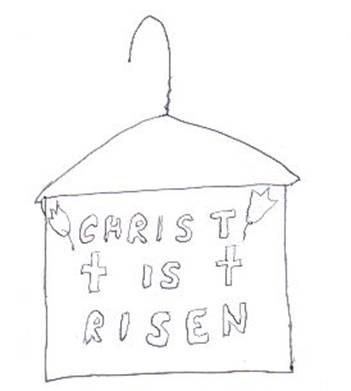
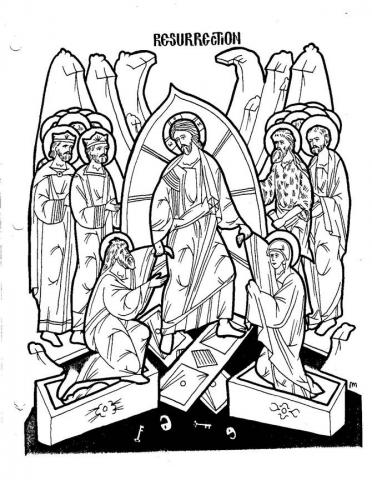
Doubting Thomas
DOUBTING THOMAS
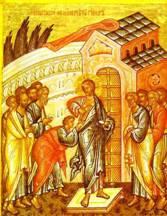
Objectives:
- Students should recognize the name of Thomas as a disciple.
- Students should be able to tell the story of Thomas in their own words.
Possible Lesson Plan:
- Open with prayer.
- Read the story of Thomas in John 20:24-29. Who was Thomas? What happened to the other disciples? Was Thomas there? What did Thomas say? What did Jesus do? How did Thomas respond? Why is he known as “Doubting Thomas”?
- Talk a bit about doubt: Has someone ever told you something that was hard to believe? Listen to the children’s stories of things they would find hard to believe. If someone told you he saw a dead man walking around, would that be hard to believe? Did Thomas believe the other disciples? Would you? Talk a bit about the normal, expected way things usually are: Can the children describe some things that we know should happen in a certain way or look a certain way? Maybe, things fall down, not up; we walk on our feet and not our heads; leaves are green and not purple. Life is full of normal, everyday things and it would be impossible to live life otherwise. Imagine a world where things fell up, down, or sideways at random, where …(go on with your children’s list). But, do things always have to be normal? Is God in charge? Can He change anything He wants when He needs to? So He can and did change death, and surprised poor Thomas.
- Play a learning game: Don’t Make a Move. Take 10 popsicle sticks, numbered 1-10, and drop in a pile on the floor. Write 10 questions about today’s lesson on 10 numbered pieces of paper. Each player, in turn, attempts to pick up a stick without disturbing the rest. If successful, he gets to try to answer the question with the same number and earns a point if correct. If he moves the other sticks, or cannot answer the question, play passes to the next player.
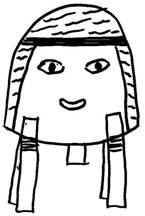
- Make Storybook People of Jesus and Thomas. Use a L’eggs egg half or a Styrofoam cup. Clip on clothespins for legs (3 or 4, or it won’t stand up!). Draw on the faces. Draw the clothing, or use fabric. What about yarn for hair? How would Thomas look? Surprised? What about a crown of thorns on Jesus made of pipe-cleaners? Can the children tell the story with dialogue for each of the characters?
Close with prayer.
Myrrh-bearing Women
THE MYRRH-BEARING WOMEN
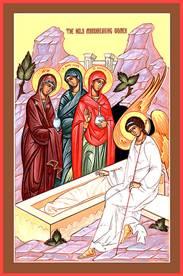 Objectives:
Objectives:
- Students should be able to say the word “myrrh” and know its meaning.
- Students should be able to tell the story of the myrrh-bearing women in their own words.
Possible Lesson Plan:
- Open with prayer.
- Scripture References: Luke 23:55-24:9, Mark 16: 1-11. Like the disciples, these women had followed Jesus all the way from Galilee to Jerusalem. They had listened to His teachings and knew His words were true. These women were very brave. In spite of the Roman soldiers and the mocking crowd, they followed our Lord to His cross. When all of the disciples (except whom? John) and run away, they had stayed at the cross. They went with our Lord to His burial. Then, on Sunday, they came to the tomb. There are eight women typically depicted in the icon of the Holy Myrrh-bearers – Mary the Theotokos, Mary Magdalene, Joanna, Solome, Mary the wife of Cleopas, Susanna, and Mary and Martha of Bethany (sisters of Lazarus). Why were women going to the tomb? Why on Sunday? What is myrrh? What did they find? What did they do?
- Discussion: What is the meaning of death? Why does God allow death? How did death enter the world? (Review the story of Adam and Eve.) Are you afraid of dying? Why or why not? Does God care if we die? (Remember, “Jesus wept.”) Has anyone ever escaped death? Did Mary die? How do we know we have victory over death? (the resurrection)
- Discuss burial customs. What are our customs? (“Memory Eternal” or eating koliva?) The Jewish custom was to rub the body with myrrh. Why couldn’t the women do it Friday night? (the Sabbath) Where was Jesus’s body put after He died? Can you remember whose tomb it was? We usually bury people in the ground and fill the grave with dirt. How was the tomb of Jesus sealed? (stone) How did the women feel when the stone was rolled away? How would you feel if the grave of a loved one were found dug up? But, Jesus’s body wasn’t stolen; He told the women He had risen from the dead! How did they feel now? What did they do?
- Play a learning game: Verse Scramble. Divide the class into 2 teams. Choose 5-10 verses or pieces of verses from today’s lesson. Make two identical sets of cards for each verse, one for each team. Each set should consist of several cards, each card with 1-3 words from the verse. Mix up the cards for each verse and paperclip together until class time. Place the first set of cards in front of each team. At “Go” the team tries to arrange the cards in order. When they are all in place, the players stand holding the cards so the verse can be read in order. That team gets the point. Then, move on to the next verse. Suggested verses?
Mark 16:2 Mark 16:5 Mark 16:6 2nd part
Luke 24:2 Luke 24:5 (quote) Luke 24:9
- Make a Spicebraid for a Mother’s Day gift. Begin with 6 3-foot lengths of yarn for each child. Fold over in the middle. Tie with a bow at the fold and 1 inch below it. Braid the yarn all the way down and tie with a bow at the bottom. Make several small
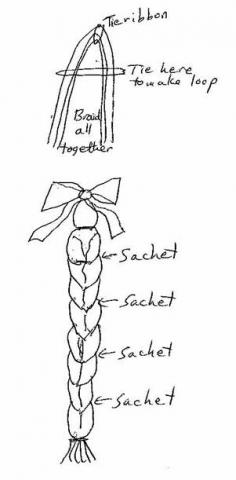 sachets with a circle of fabric filled with spices and tied with a ribbon. Use the ribbon to tie the sachets along the length of the braid. Hang it at home for all to enjoy.
sachets with a circle of fabric filled with spices and tied with a ribbon. Use the ribbon to tie the sachets along the length of the braid. Hang it at home for all to enjoy.
Prefer paper crafts? Make this stand-up diorama card. Print the background and icon pieces, angels and women, on cardstock and cut out. Cut slits where shown on the background. Bend background forward at the junction between rock and grass. Insert angels (black line) and women (red line) in place and tape behind. You have a stand-up card that will flatten down to mail to your favorite auntie or grandma.
- Close with prayer. Consider the "holy myrrhbearers" of your own parish, those women who prepare the flowers, the tomb, the many other services needed, done silently and without fanfare, and pray for them especially today.
Road to Emmaeus
THE ROAD TO EMMAEUS
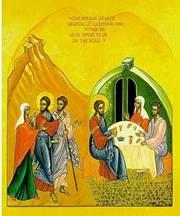
Objectives:
- Students should be able to tell the story of the road to Emmaeus in their own words.
- Students should know that the disciples recognized Jesus in the breaking of the bread.
Possible Lesson Plan:
- Open with prayer.
- Read the story of the Road to Emmaeus in Luke 23:13-39. Where were the men going? Why? Who was the stranger? When did they know that He was Jesus? Review the story of the Last Supper, when Jesus last broke bread with His disciples.
- This is a good time to review, as Jesus did, the span of the Old Testament and prophets and what they said about the Messiah. When did people first disobey God? Review the story of Adam and Eve. Over and over, God saved His people: Noah and the ark, Abraham and Isaac, Moses and Passover, Jonah and the big fish, the three boys in the fire, Daniel in the lion’s den. In each case, God provided the means of saving His people. What were they? (ark, ram, blood of lamb, fish, Jesus Himself, an angel) He gave His people His law, the Ten Commandments, but they disobeyed even that. Now He has given His Son to save us all!
- Play a learning game: Map Search – a review. Divide into teams. Using the original blank map from earlier in the year, ask the first team to locate one of the places marked or Emmaeus. If they locate it correctly, they receive the point and get another turn. If they cannot, the missed place passes to the other team for a try at a point. Continue until all places are correctly identified.
- Decorate a hiking stick, like the ones the men might have used to walk to Emmaeus. The students will have chosen sticks at the camping trip last weekend. Bring acrylic paints for them to decorate them. Using Christian symbols? After they dry, spray with clear spray to fix the paint.
- Close with prayer.
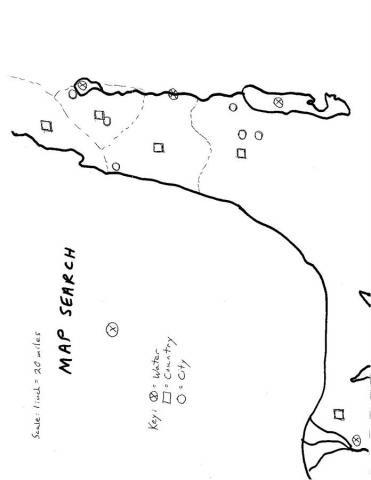
Ascension
ASCENSION
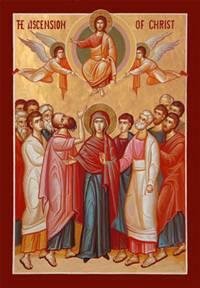
Objectives:
- Students should understand the icon and its characters and be able to tell the story of the Ascension.
- Students should know that Ascension occurs 40 days after Pascha.
Possible Lesson Plan:
- Open with prayer.
- Review the icon, seeing how much they already know: Christ is the central figure, clothed in white (Why?) and bestowing a blessing on the world with hands outstretched, the Theotokos just below Christ, the disciples (including whom as a replacement for Judas? Matthias) Are they in the city or the countryside?
- Scripture References: Mark 16:15-19, Matthew 28:16-end, Acts 1: 1-12
- Discussion questions:
What were Jesus’s promises on Ascension? (there are 3: to send the Spirit, to be with them always, and to return in glory) What did He tell his disciples to do? Where did the Ascension occur? (on the Mount of Olives, near Bethany) In what way is the Ascension the crowning of the Paschal mystery? Which of the apostles pictured in the icon could not possibly have been there? (St. Paul) Why? (He was converted on the road to Damascus, much later.) Why is he pictured in the icon? (He was a witness to the resurrection just like the others since Jesus Himself appeared to Saul.)
Where does Jesus sit now? (at the right hand of the Father) Where is that? (the point here is that it is not an earthly place; thus the angels asked the bewildered disciples why they were looking at the sky) A cloud came and removed Jesus from the sight of His disciples; where else do we see a cloud with a divine appearance? (Red Sea, Mt. Sinai and the 10 Commandments, Mary at the Annunciation, Transfiguration) What did the apostles do between Ascension and Pentecost? (wait!!!) Compare and contrast Ascension and Transfiguration.
- Play a learning game: Outguesser. Give each student a piece of paper and pencil. Have them make 2 columns – People Present and Countries of the World. Give them a set time to list as many in each column as possible. When time is up, the student with the most correct answers is the winner.
- Make the Great Commission Plates. Bring in a globe. On one side of a paper plate have the students draw the world, continents and oceans, with blue and tan crayons. Copy the icon and have the students color it. Cut it out in round shape and glue to the other side of the plate. Print with black marker, “Go Ye,” on the side with the world, and the other already says Ascension. Remind the students that Jesus gave us the Great Commission at His Ascension. What is the Great Commission? “Go ye, therefore, and make disciples of all the nations…” Punch a hole in the plate and hang it with a string so it will spin around.
- Alternate craft idea. Print icon of Ascension on heavy paper or cardstock. Have students color it. Then cut it apart from behind as a puzzle. Can each put together the other’s puzzle.
8. Sing the song “Spread the Good News”:
Jump to the left and jump to the right (jump left, jump right)
And sing to the Lord with all of your might! (song directing, strong arms)
Raise your hands and wave them in the air (raise hands, wave around)
And spread the Good News everywhere! (lower hands in a circle)
9. Close with prayer.
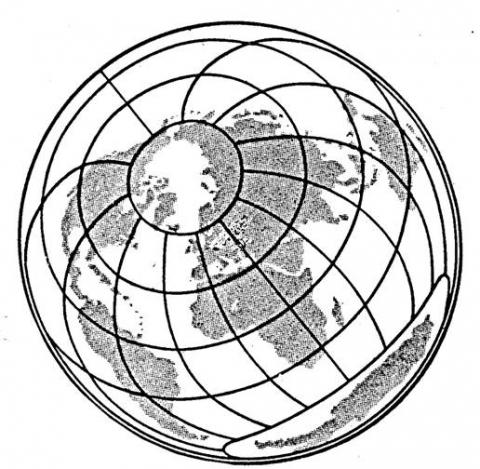
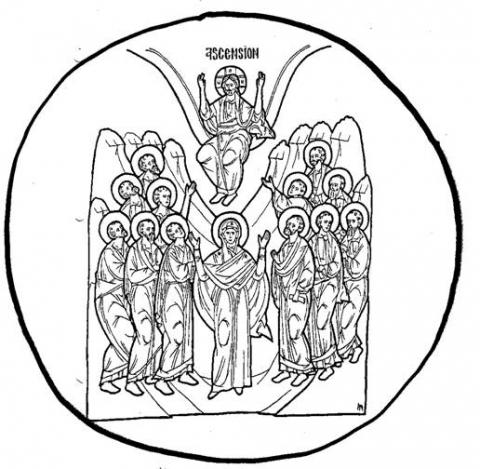
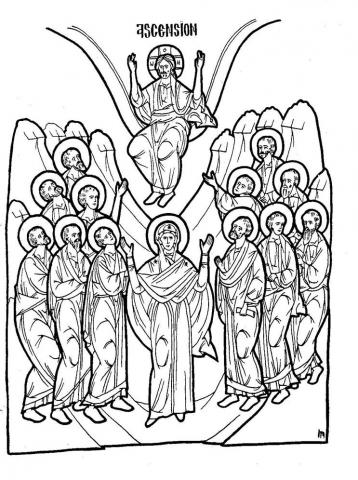
Pentecost
PENTECOST
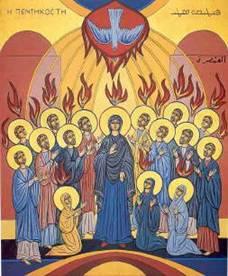
Objectives:
- Students should understand the icon and its characters.
- Students should know that “Pentecost” means “fiftieth” and is celebrated on the fiftieth day after Pascha.
- Students should understand why Pentecost is called the birthday of the Church.
Possible Lesson Plan:
- Open with prayer.
- Review the icon; what do they already understand? The disciples are gathered in the upper room (What last happened there? the Last Supper), in some icons each has a flame above his head (Why?), the book of the Gospels sits in the center, by which the Holy Spirit has revealed the spiritual presence of Christ to the world, the little crowned figure seated in the middle is the world! There is an empty place at the top of the horseshoe formed by the apostles; who will fill this place at the Second Coming? The icon shows only 12 apostles; how many believers were actually there?
- Scripture Reference: Acts 2:1-18, 36-41.
- Songs of the Feast: Sing It!
O Heavenly King: O heavenly King, the Comforter, the Spirit of Truth, Who art everywhere and fillest all things, Treasury of blessings and Giver of light, Come and abide with us, and cleanse us from every impurity, and save, O good One, our souls.
- Discussion questions:
What happened at Pentecost? Who descended? Who is the Holy Spirit? In which other feast did we meet the Holy Spirit? (as a dove at Theophany) In what sacrament do we receive the Holy Spirit? (Chrismation - Greek “chrisma” meaning anointing) How does the Spirit, God Himself, dwell in us? How can we tell He does – did we see tongues of fire? This is a great mystery, as are all the sacraments. Why is He called “Comforter”?
Why do we decorate the Church in green? (as a sign of the life the Holy Spirit brings us) In what way is Pentecost the birthday of the church? (the first Christians were baptized by the apostles) What changed the frightened disciples into the power-filled apostles? How did the apostles use their new power in the Holy Spirit?
Why were there so many Jews in Jerusalem from all over the world at that time (50 days after Passover) anyway? (They are also celebrating Pentecost, the giving of the Law 50 days after Passover on Mt. Sinai; it is also the “Feast of Weeks” and the thanksgiving for the harvest) So the Old Covenant Pentecost, the Law, is supplanted by the New Covenant Pentecost, the Spirit.
How do we end the Pentecost celebration? (with kneeling vespers, we again kneel in a spirit of penitence, which we will keep until the next Paschal season.
- Play a learning game: Alphabet Search. Bring in your Scrabble tiles or make
small squares of paper with letters on them – 2 full sets and several extra of each vowel. Place the squares in the center of the room. Ask a question from the lesson that can be answered with one word. The first player to lay out squares to spell the correct word is the winner of that round.
- Make “Pentecost Placemats”: Give each child a piece of construction paper with a face shape. Have them color the face and draw in hair, eyes, etc. Glue a paper flame above the head. Cover with clear contact paper so it will wipe clean.
- Close with prayer. Sing or recite “O Heavenly King”.
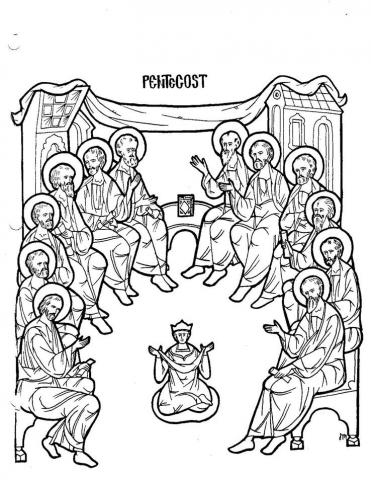
Lord's Prayer
THE LORD’S PRAYER
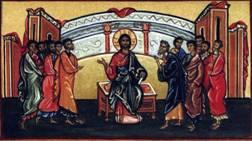 Objectives:
Objectives:
- Students should identify the Lord’s Prayer, or “Our Father”, as the prayer that Jesus taught His disciples.
- Students should memorize the Lord’s Prayer.
Possible Lesson Plan:
- Open with prayer. Use the Lord’s Prayer.
- Scripture Reference: Matthew 6:5-15. The disciples asked Jesus how to pray the right way. This is the prayer Jesus gave them. Go through the prayer line by line with the children:
“Our Father”: What’s a father like? Who is your father on earth? God is our father, too.
“Who art in Heaven”: Where does God live? What’s heaven like?
“Hallowed be Thy name”: “hallowed” means “holy”; what’s holy mean?
“Thy kingdom come”: What is God’s kingdom?
“Thy will be done on earth as it is in heaven”: Why do things happen to us? Who is in charge?
“Give us this day our daily bread”: Remember the Sermon on the Mount? God even feeds us and takes care of us.
“Forgive us our trespasses”: Do we ever do anything wrong? Do we need forgiveness?
“As we forgive those who trespass against us”: Has anyone ever done anything unkind to you? Have you forgiven that person?
“And lead us not into temptation”: Remember Jesus’s temptations? Is it hard to always obey God?
“But deliver us from evil”: Who is the source of evil? Did Jesus win even over the devil?
- Talk a little about prayer: When and where do we pray? Ask the children how prayer is done in their homes. Do they pray before meals? Do they pray in the morning or the evening? Do they have an icon corner? Do they pray at bedtime? Remind them to say the Lord’s Prayer every morning and evening.
- Play a learning game: Verse Scramble. Write each line of the prayer on a separate piece of paper. Give each player a piece. They must line up in order, then read the whole prayer in order with each player reading his own card.
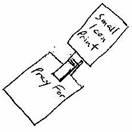
- Make a Prayer Reminder: Take a clothespin and apply adhesive magnet strip to one side. Glue a small icon on the other side; we have lots of old bulletins to cut up. Cover it with Contact paper if desired. Take a small pad of Post-It Notes and have the students write on each slip “Pray For”. Take home and stick to refrigerator, beginning with the prayer requests of their friends in class today.
- Alternate craft idea: Copy the Lord’s Prayer on the next page, or have the students letter their own on a precut puzzle or a piece of heavy paper, decorate it and cut out pieces.
- Close with the Lord’s Prayer.
